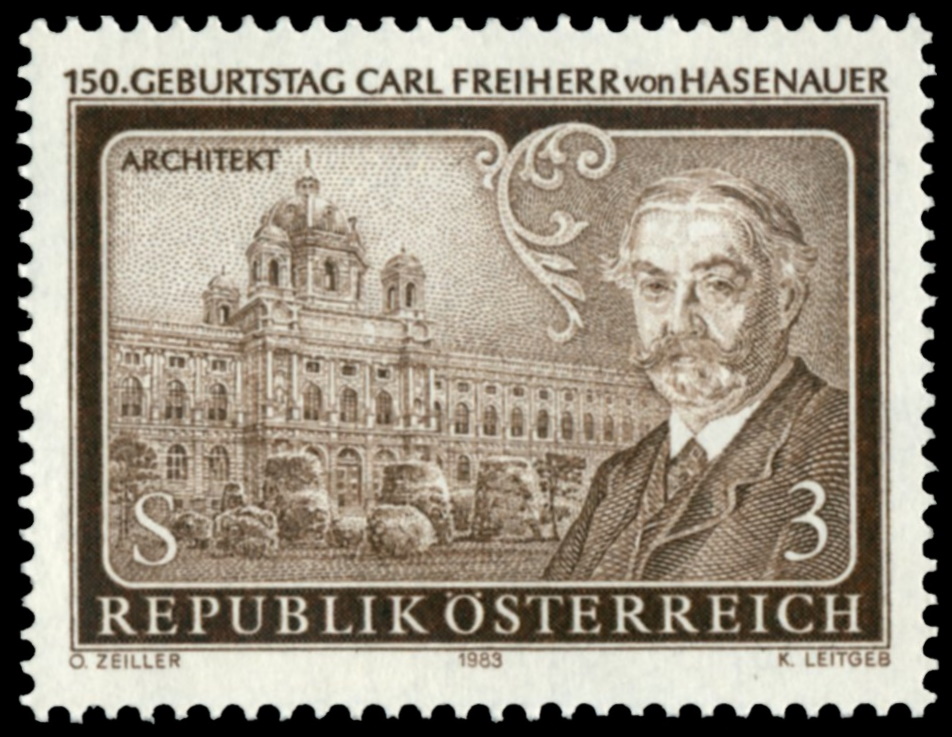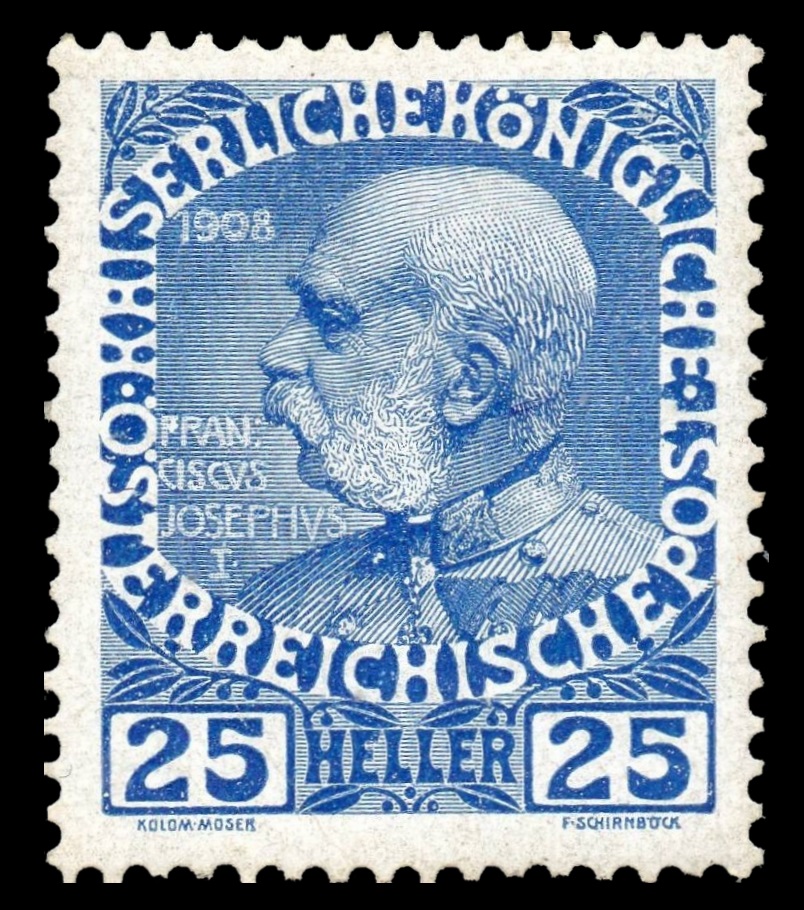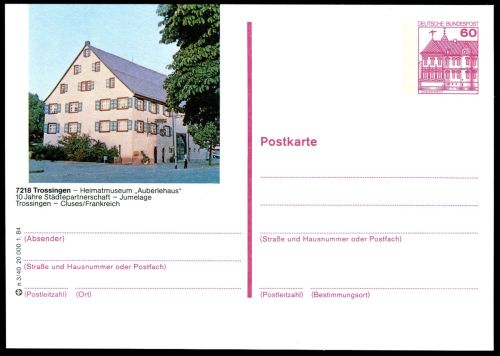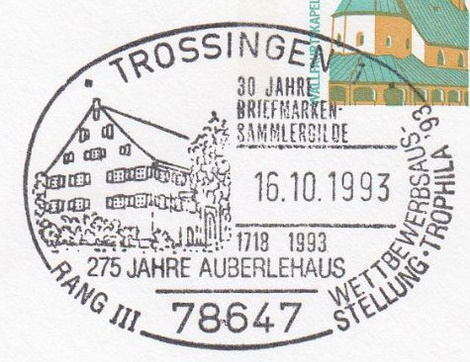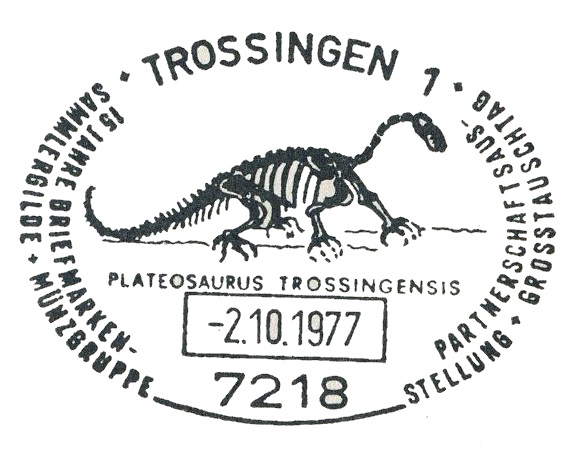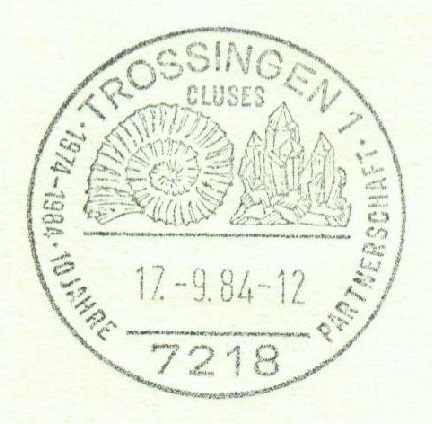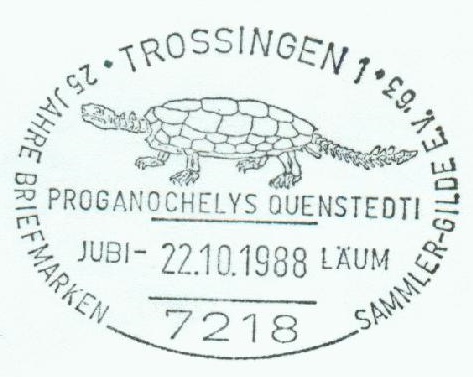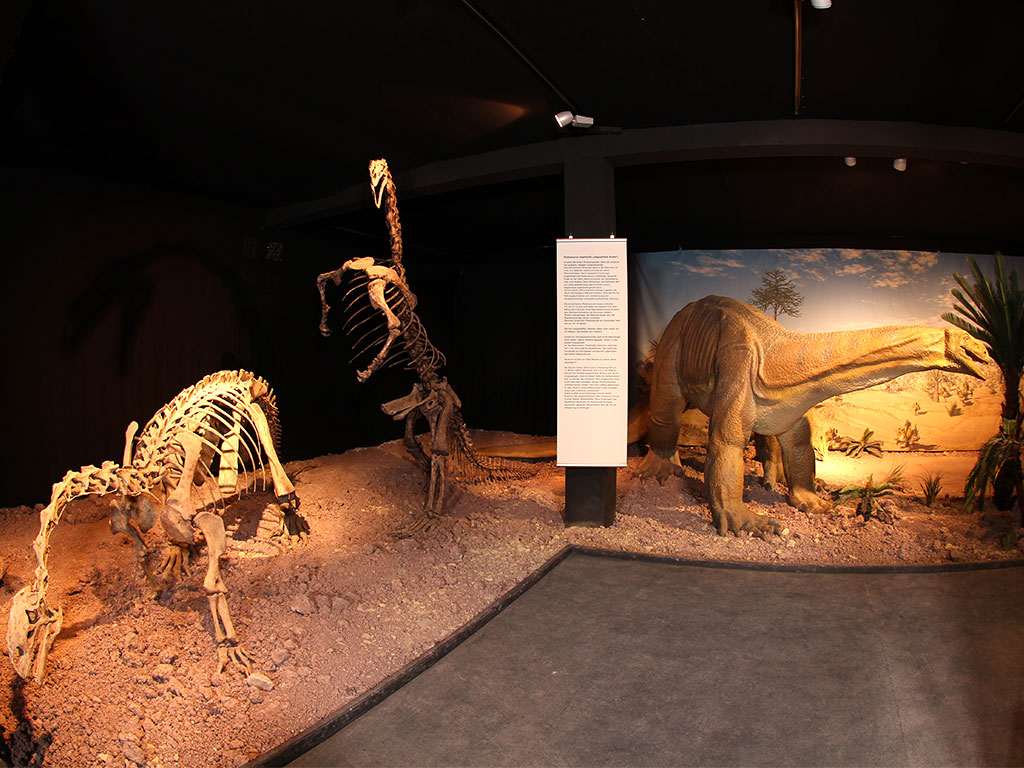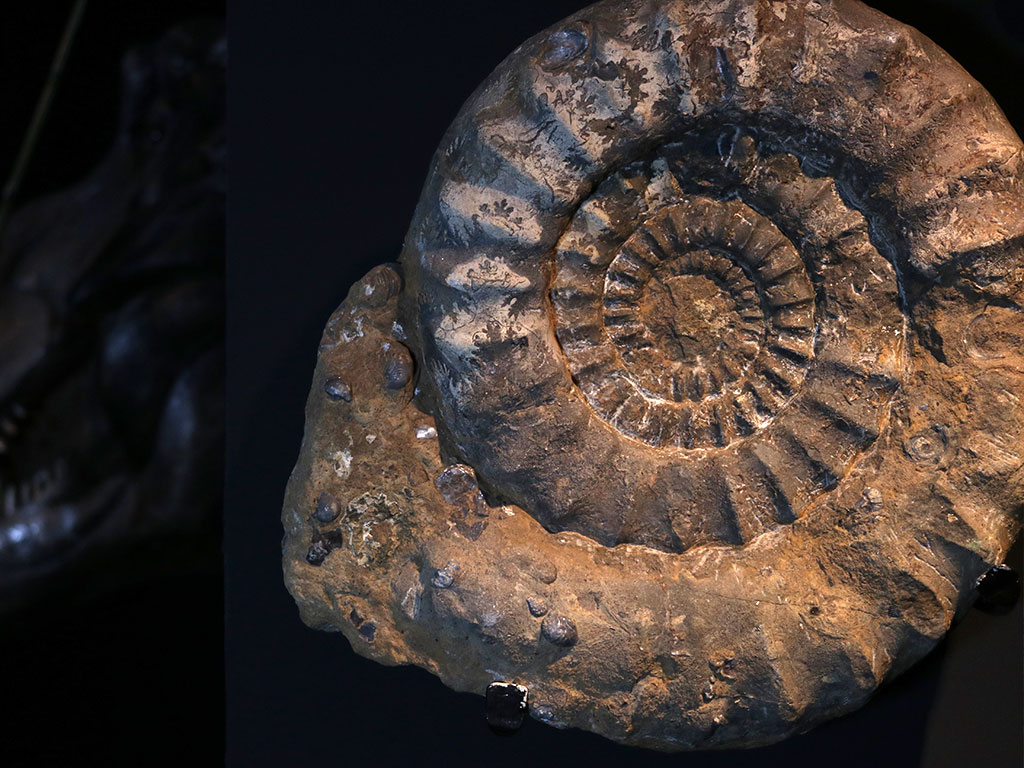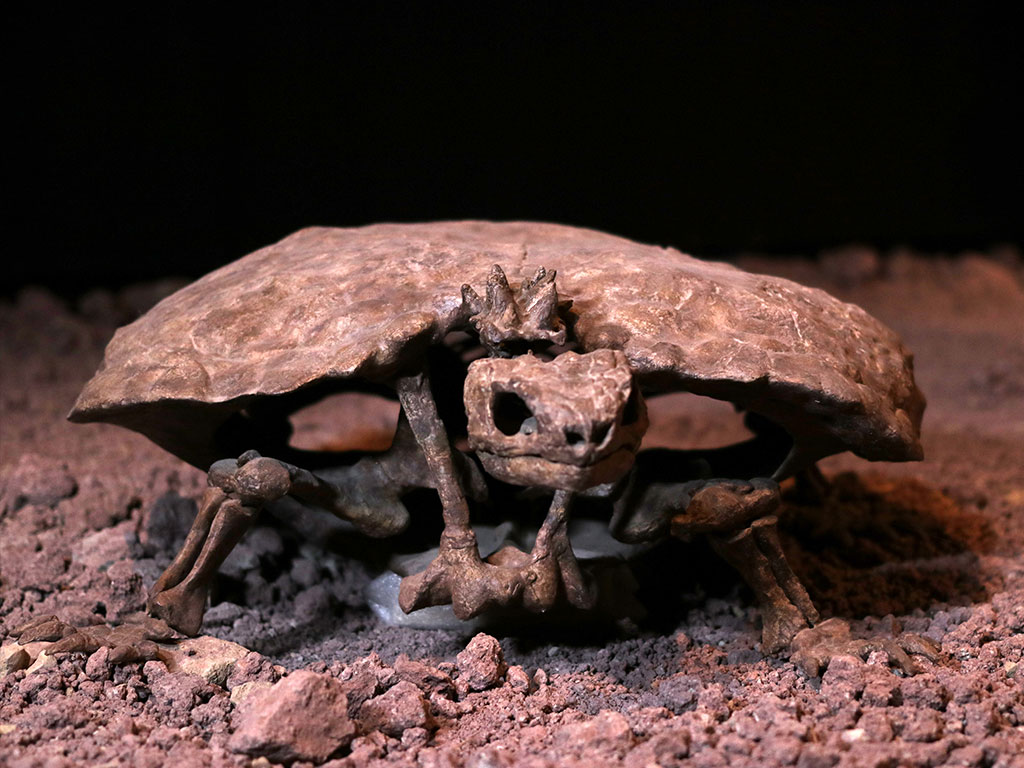the place where Paleontology and Paleoanthropology meets Philately
Paleontological Museums, Research Institutes on stamps and other philatelic items
UNDER CONSTRUCTION
The list of Museums and the Research Institutes:
Argentina
The “Bernardino Rivadavia" Argentine Natural Sciences Museum, (MACN — CONICET) is the oldest in the Argentine Republic.
Thw museum was founded in 1812, only two years alter the May Revolution in 1810; thus its birth should be interpreted with regard to a national identity construction project as well as with the development of scientific history in the early Modern Age.
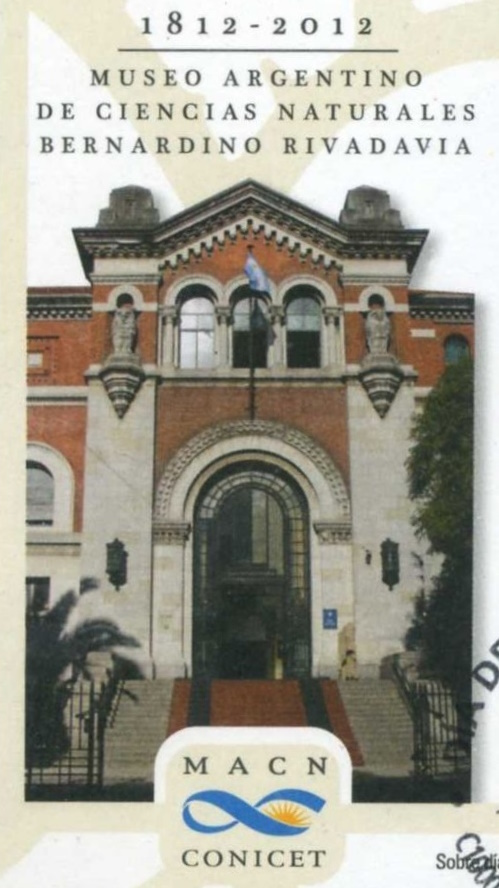 |
| The Bernardino Rivadavia Argentine Natural Sciences Museum on cachet of FDC from 2012, "200th Anniversary of Natural Sciences Museum". |
During all those years, different personalities that lead the Museum gave their own particular style and vision to its management.
When Hermann Burmeister was named director in 1862 began a 30-year management that became the most significant in the Museum's history, due the magnitude of the implemented changes. During this stage the institution had a strictly scientific orientation and became an internationally renowned paleontological centre. In 1892 Burmeister was followed by Karl Berg, who had in mind a much more open museum. He therefore worked intensely to give the public greater access to all exhibits.
In 1902 palaeontologist Florentine Ameghino became the first Argentine director of the Museum. In those times material started to saturate the buildings capacity up to a point that it became necessary to close its doors for lack of space. The Museum reopened in 1916. Under the direction ol Martin Doallo-Jurado (1923-1946) the new building in Parque Centenario was built and the Museum moved in there. This innovative management centred on increasing collections, gave impulse to research and intense disclosure of knowledge.
In 1999 Dr. Edgardo Juan Romero assumed as director. In 2011 Doctor Pablo Tubaro its present director, started his management. New in 2012, the Museum's Bicentenary, the institution is working hard to achieve a new balance between research and museology. Collections are preserved and studied by specialized researchers and technicians. Research jobs are not only performed at the lab, but the researchers also hold study and material collection campaigns and advice other entities in Argentina.
The museum, the most important of its kind in Buenos Aires and second only to the La Plata Museum of Natural Sciences, nationwide. Besides the Natural Sciences Institute, the museum houses thirteen permanent exhibition halls, including an aquarium, a display with specimens collected from Argentina's numerous research stations in Antarctica, a geological collection centered around meteorites found in Argentina, a paleontology section notable for its Carnotaurus, Eoraptor, Herrerasaurus and Patagosaurus fossils, among others, and a Cenozoic paleontology display featuring Glyptodon, Macrauchenia, Megatherium and Smilodon fossils. [R37]
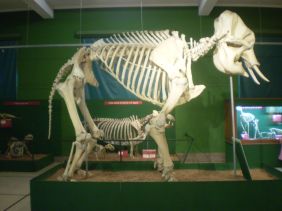 |
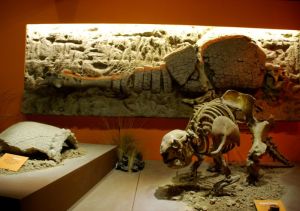 |
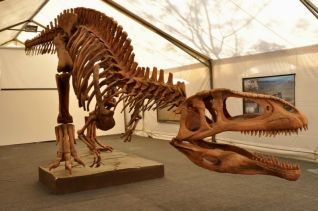 |
| Some fossils from collection of the Bernardino Rivadavia Argentine Natural Sciences Museum | ||
Known Philatelic items:
commemorative set of 4 stamps of Argentina 2012 "200th Anniversary of Natural Sciences Museum".
Argentina: The Museum of La Plata, is the Natural History Museum in La Plata, Argentina.
The museum, connected with the National University of La Plata, houses one of the most important paleontological and anthropological collections in South America.
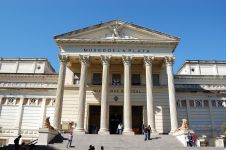
|
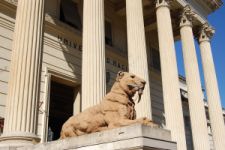
|
|
The main entrance to the museum and one of the Smilodons at the entrance. Both image are from Wikipedia |
|
The La Plata Natural Sciences Museum was built in 1884 and it is one of the oldest Natural History Museums in South America. The collection of the Vertebrates Paleontological Division (DPV) was created in 1877, when Dr. Francisco Pascasio Moreno, who was the first director of the museum later on, donated 15.000 pieces.
The current collection of the museum contains around 4 million items, mostly from Argentina and other South American countries.
The permanent exhibits are organized in 20 rooms located over two floors. The exhibits display the entire natural history of our planet from the formation of the Universe, through the origin of life, and even the origin of humans and their cultures. [R7]
Two Smilodon sculptures stand at the entrance of the museum.
Known Philatelic items: (the Smilodon statues can even be seen on some of the stamps!):
- 1933: The museum is in the background on the stamp with face value of 30C
- 1958: The stamp dedicated to the anniversary of the city of La Plata shows the Museum Building.
- 1978: Between July 25 and August 30 post of Argentina issued five definitive stamps of famous buildings. The first stamp of the set shows the museum.
- 1982: The stamp on the bottom-right corner of the Mini Sheet shows the museum.
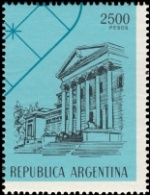
|
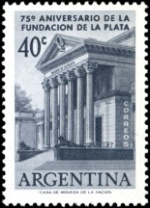
|
| Argentina 1982, MiNr. 1604, Scott: 1400f | Argentina 1958, MiNr.: 667, Ssott: 670 |
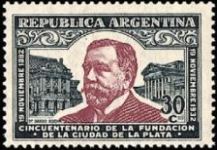
|
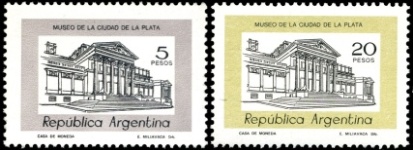
|
| Argentina 1933, MiNr. 394, Scott: 413. The museum is shown on the right side of the background. |
Argentina 1978, MiNr.: 1334, Scott: 1159 (25.07.1978) and MiNr.: 1335, Scott: 1162 (08.09.1978) |
Austria
Krahuletsmuseum in Eggenburg
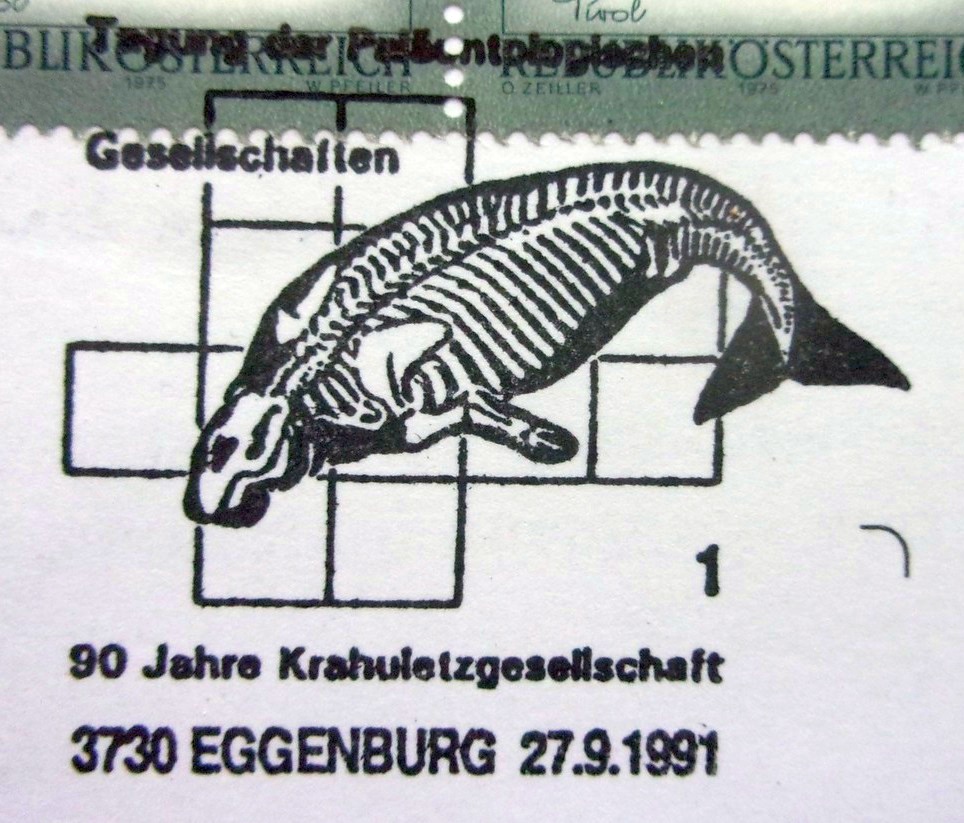
|
| Postmark of Austria 1991 - Krahuletsmuseum in Eggenburg |
Fossil animals such as the Eggenburger Krokodil or the manatee Metaxytherium krahuletzi are among the highlights of the museum collection and established their worldwide fame.
The Eggenburger Krokodil, whose scientific name is Gavialosuchus eggenburgensis, lived about 20 million years ago in the estuaries on the edge of the Eggenburg Sea, similar to today’s Gavial and fed mainly on fish.
Manatee - shown on the postmark and on the logo of the museum. The scientific name of these manatees is “Metaxytherium krahuletzi”, they were named after Johann Krahuletz, who had found the first bones.
They lived about 20 million years ago on the coast of the tropical Eggenburg Sea.
In the communal sand pit of Kühnring seven almost complete skeletons of manatees were discovered, which likely died together during a storm surge and debris avalanche. [R8]
Known Philatelic items: commemorative postmark of Austria 1991 (see above) "90 years of Krahuletsmuseum in Eggenburg. Meeting of Palaeontological society"
Austria
The Museum of Natural History Vienna (German: Naturhistorisches Museum Wien), is among the largest of its kind and one of the most important museums in Europe.
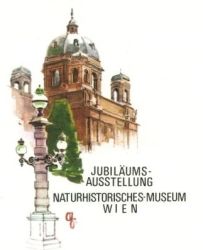
|
| The Museum of Natural History Vienna on cachet of FDC of Austria 1976 |
Precious minerals, rare fossils, huge dinosaurs, and unique prehistoric findings, such as the famous Venus of Willendorf, are presented on the mezzanine level. The first floor is dedicated to the immense variety of animal life.
Behind the scenes, collections comprising some 25 million specimens and artefacts are the essential basis for the work of over 60 staff scientists.
Their main fields of research cover a wide range of topics from the origins of our solar system and the evolution of animals and plants to human evolution, as well as prehistoric traditions and customs.
Guided tours, presentations, and workshops on a variety of themes are offered regularly.
These events not only provide insight into interesting and surprising natural phenomena, but also deal with the fascinating results of scientific research.
The earliest collections of the Natural History Museum Vienna date back more than 250 years.
It was Emperor Franz I Stephan of Lorraine, Maria Theresa’s husband, who in 1750 purchased what was at the time the world's
largest and most famous collection of natural history objects from the Florentine scholar and scientist Jean de Baillou.
This was the first step on the road to creating the Natural History Museum Vienna.
The Natural History Museum and the Museum of Fine Arts were commissioned by Emperor Franz Joseph I (1830 – 1916)
and designed by the architects Gottfried Semper (1803 – 1879) and Carl Hasenauer (1833 – 1894).
(Carl Hasenauer was commemorated on an Austrian stamp in 1983. See on the right)
The two museums have identical exteriors and face each other.
They were originally designed to be part of a much larger project – an Imperial Forum – which was never realized in full.
Work on the Natural History Museum lasted from 1871 until 1881.
On August 10, 1889 Emperor Franz Joseph I himself officially opened the museum.
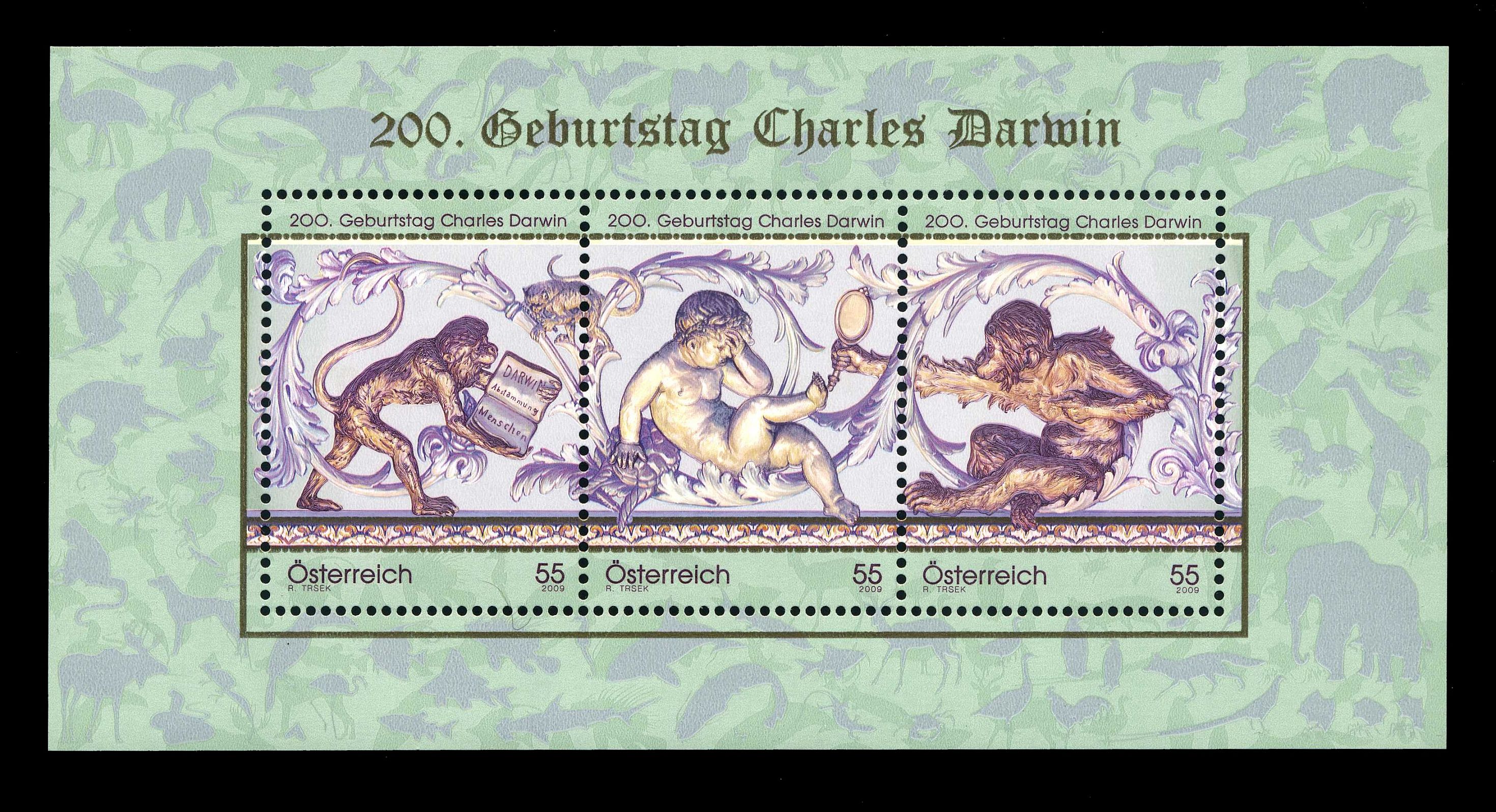
|
| Stamps of Austria 2009 - "200th anniversary of the birth of Charles Darwin", MiNr.: Bl. 57, Scott: 2234 |
This was largely thanks to the determination and vision of the museum’s first Director, Ferdinand von Hochstetter (1820-1884), who had been an enthusiastic supporter of Darwin from the very start.
By incorporating his new Anthropological-Ethnographical Department into the existing museum, Hochstetter created the first museum of nature where humans were also presented as an object of research.
Hochstetter also used the interior design of the museum to communicate Darwin’s theory to visitors.
The most direct reference to Charles Darwin’s Theory of Evolution can be found in the Upper Dome Hall.
It is the Darwin Frieze by Austrian sculptor Johannes Benk (1844-1914), showing an ape pointing to its own chest and holding
a mirror out to a boy, who is covering his eyes because he does not want to see his own reflection and the ape.
A monkey behind the boy is holding an open book entitled “Darwin. The Descent of Man”.
With this scene Johannes Benk directly addresses visitors to the museum and confronts them with the realization that humans are descended from animals. [R1]
The Frieze was shown on the Austrian stamps "200th anniversary of the birth of Charles Darwin" in 2009 (see on the right).
 |
 |
| The Museum of Natural History, Vienna is depicted on not only meter frankings (showing the Museum), but was also used on meter frankings to advertise their exhibits or upcoming events. | |
Known Philatelic items:
- commemorative stamp "Vienna Natural History Museum Centennial" of Austria 1976, show an Ammonite from the collection of the museum. The Museum is depicted on the cachet of an official FDC. MiNr.: 1501, Scott: 1032.
- commemorative stamp "150th anniversary of Carl Freiherr von Hasenaer" of Austria 1983, MiNr.: 1746, Scott: 1248.
- commemorative set of 3 stamps, printed in the Souvenir Block "200th anniversary of the birth of Charles Darwin" of Austria 2009.
- several meter frankings that shows the building of the museum and some of the Museum's artefacts.
Austria
Haus der Natur A Universal Museum of the Natural Sciences in Salzburg.
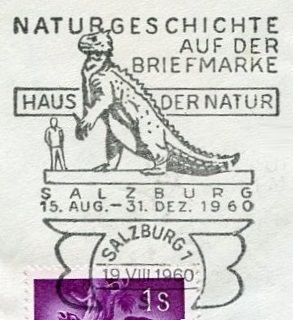
|
| Haus der Natur Salzburg on postmark of Austria 1960 |
Since its founding, it has continually taken its visitors by surprise with a lively and modern educational approach that has continued to develop steadily over the years.
Today the Haus der Natur is a “three-division institution” with a regional and international focus.
It encompasses the classical natural history museum, high-quality zoo divisions, and a Science Center with a broad and varied offering.
With over 7000 square meters of exhibit space, the Haus der Natur is currently Salzburg’s largest museum.
The museum was conceived and founded in 1924 by Eduard Paul Tratz as “New Natural History Museum”.
It was originally located in the former Hofstallkaserne, in what is today the Salzburg Festival Hall.
In 1936 the museum was renamed “Haus der Natur”. [R8]
The museum contain several halls about Life Evolution: PREHISTORIC TIMES AND DINOSAURS, ICE AGE AND CLIMATE and more.
The PREHISTORIC TIMES AND DINOSAURS Hall covers the entire Mesozoic Era, encompassing the Triassic, Jurassic, and Cretaceous periods,
dinosaurs were the dominant group of animals.
Here visitors can view them as original fossils, high-quality casts, and in the case of the Allosaurus, as a roaring mobile replica.
Also on display: the largest completely-extant skeleton of a Steneosaurus, original fossils of
Ichthyosaurs –
one of the most valuable is the skeleton of a female with two embryos in her body about to be born – and the Mastodonsaurus,
the largest amphibian of all time.
The exhibition "Ice Age and Climate" provides insights into the last 2.6 million years of the Earth's history.
The Ice Age is characterized by a constantly changing climate, which changed our landscapes as well as the fauna and flora again and again.
It is also the age of the Humans who spread from Africa to the earth.
Just 20,000 years ago, the city of Salzburg was buried under a 1,000 metre thick glacier.
A special highlight is the mummy of a woolly rhinoceros from Starunia.
This is a plaster replica of the animal as it appeared when found in 1929.
The exhibition informs about details of this extinct rhino species and the unique finds from Starunia in today's Ukraine.
(Fossil and reconstruction of the woolly rhinoceros from Starunia were depicted on the cachet of
commemorative cover of Ukraine in 2009)
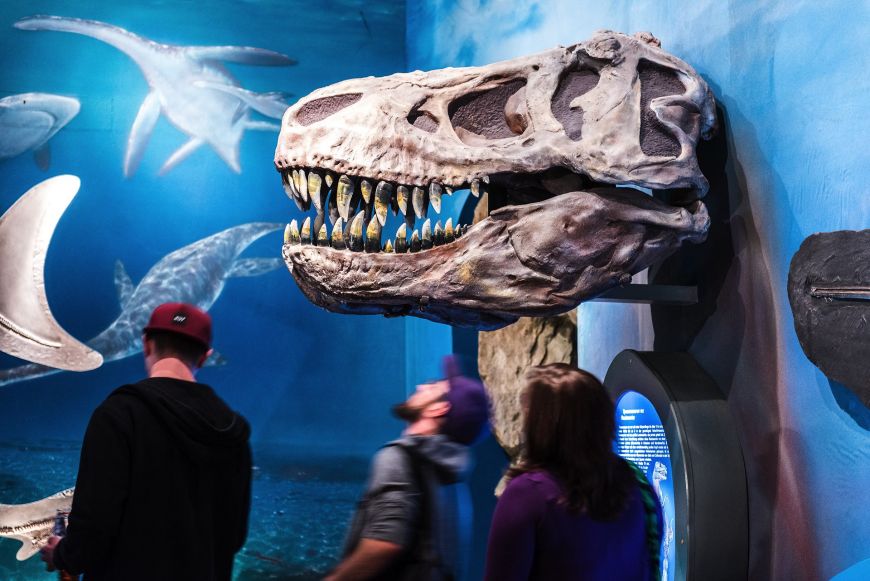 |
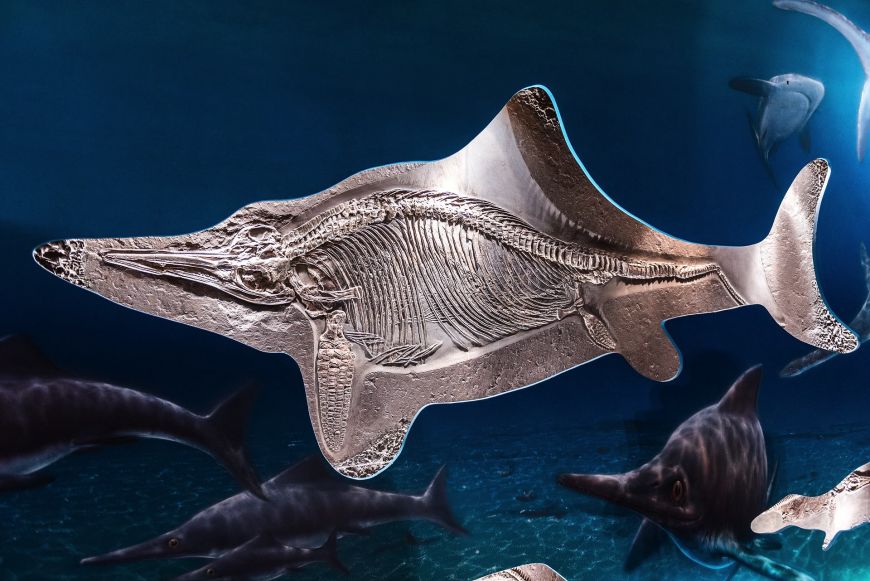 |
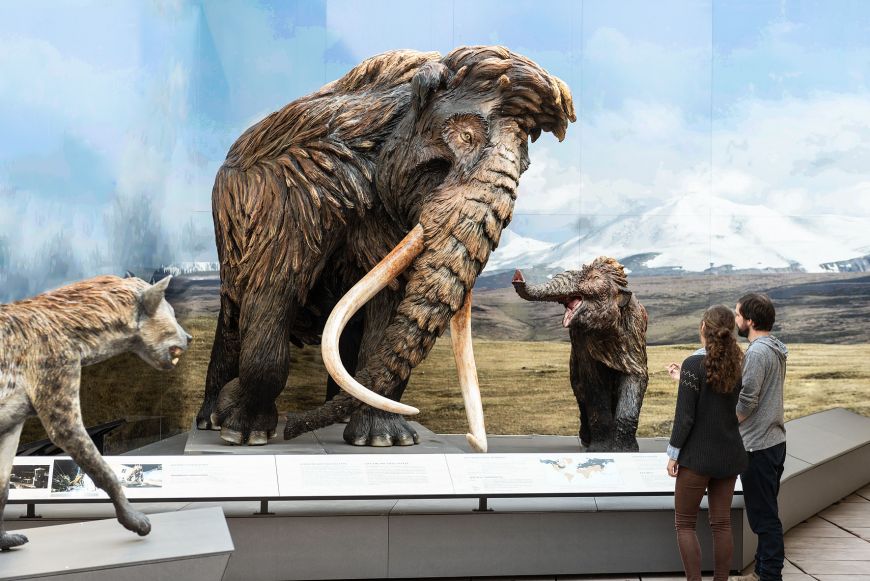 |
| Some views from The PREHISTORIC TIMES AND DINOSAURS and ICE AGE AND CLIMATE halls of Haus der Natur Museum in Salzburg. Images credit: the musuem website | ||
Known Philatelic items: commemorative postmark of Austria 1960 (see above) "Natural History on stamps"
Belgium
The Royal Belgian Institute of Natural Sciences is a museum in the Belgian capital of Brussels dedicated to natural history.
Its most important pieces are 30 fossilized Iguanodon skeletons, which were discovered in 1878 in Bernissart.
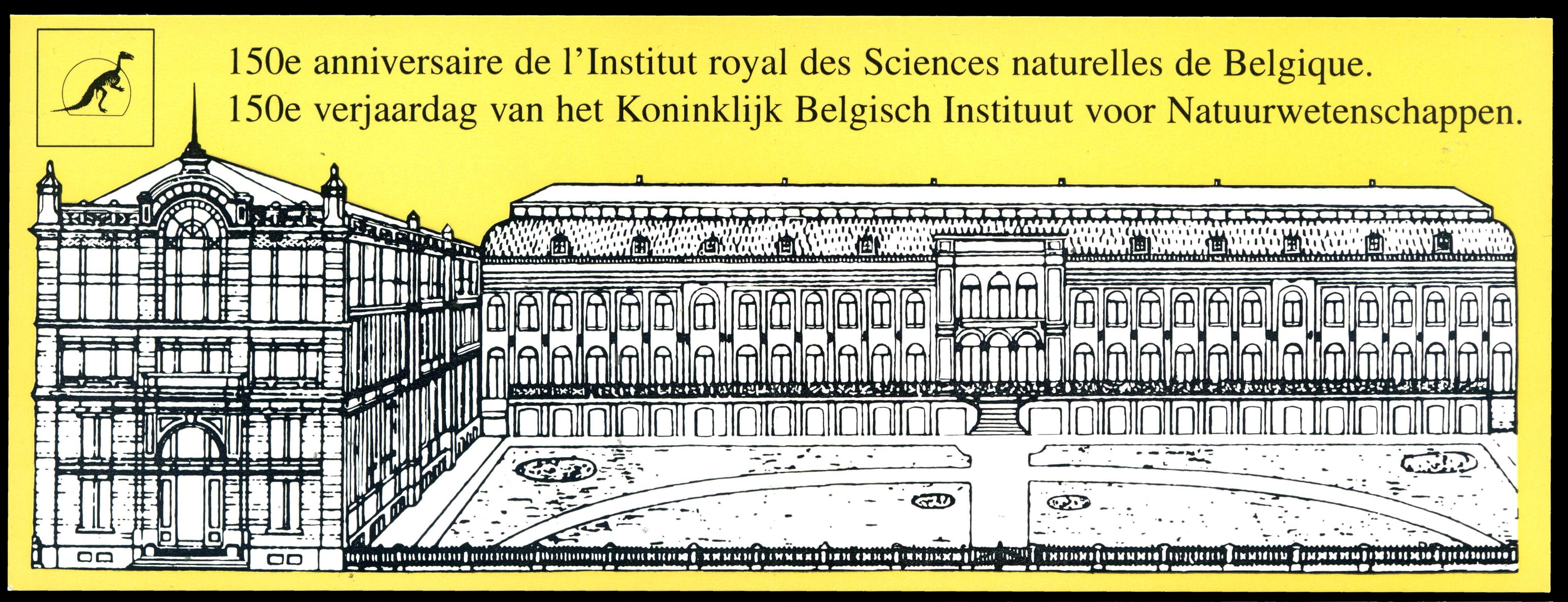 The dinosaur hall of the museum is the world's largest museum hall completely dedicated to dinosaurs.
The dinosaur hall of the museum is the world's largest museum hall completely dedicated to dinosaurs. Another famous piece is the Ishango bone, which was discovered in 1960 by Jean de Heinzelin de Braucourt.
Like in most museums, there is a research department and a public exhibit department.
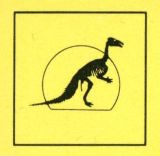
|
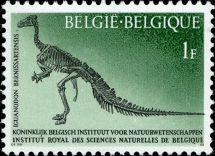
|
Stylized Iguanodon dinosaur from the reverse side of the stamps booklet. |
Fossilized skeleton of Iguanodon dinosaur on stamp of Belgium 1966, MiNr.: 1427, Scott: 664 |
Bernard du Bus de Gisignies, became the first director of the museum in 1846. On this occasion he donated 2474 birds from his own collection to the museum.
In 1860, during the construction of new fortifications around Antwerp, several fossils were found which were mainly from whales.
The museum also obtained the skeletons from a bowhead whale (Balaena mysticetus) and a young Blue Whale (Balaenoptera musculus), which are still on display in the museum.
In 1860 the skeleton of a mammoth was found near Lier and was brought to the museum (on display since 1869).
At that time the only other skeleton of a mammoth was on display in the museum of Saint Petersburg (Russia).
In 1878, the largest find of Iguanodon fossils to date occurred in a coal mine at Bernissart in Belgium.
At least 38 Iguanodon individuals were uncovered, of which 30 are on display since 1882.
Since 2007, a completely renovated and enlarged dinosaur hall (the Janlet wing) of 4580 m2 is the largest dinosaur hall in the world. [R2]
Known Philatelic items:
- The Museum is depicted on the cover of stamps booklet "The 150th Anniversary of the Institute of Science" of Belgium 1996.
- One of the skeletons of the dinosaur Iguanodon from the collection of the Museum, shown on a stamp from "National Science Heritage" of Belgium 1966.
- The Museum illustrated its cover with skeletons of the dinosaur Iguanodon from their collection. The entrance tickets of the Museum also illustrated with reconstruction of dinosaurs and other prehistoric animals
Belgium
The Royal Museum of Central Africa is recognized worldwide for its rich, varied and scientifically valuable collections.
The majority of its visitors are unaware of the size of this heritage as the permanent exhibition only has about 1% on display. The museum is known for its ethnographic objects, but its natural science collections, archives and photos are equally remarkable.
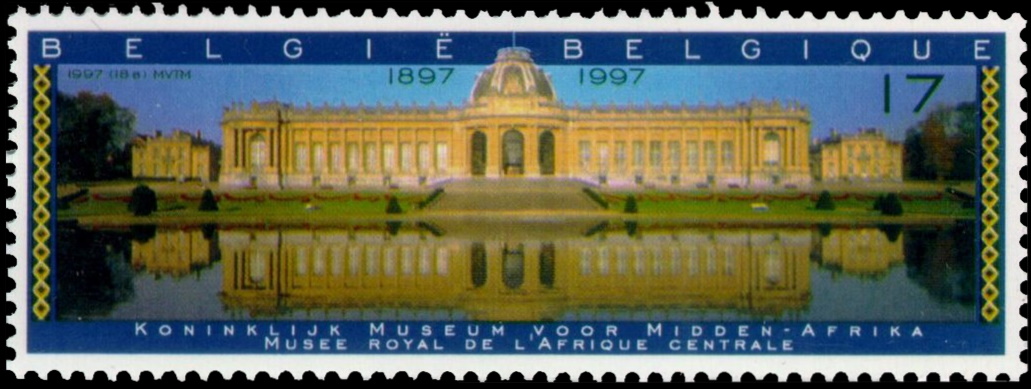
|
| The Royal Museum of Central Africa on stamp of Belgium 1997. |
The fossil collection has more than 18,000 specimens from Central
Africa, collected through fieldwork or acquired through donations.
The collection is very diverse in terms of types of specimen (from the
remains of large reptiles to microscopic skeletons of unicellular
organisms) and in terms of age (approximately 650 million years to a
few thousand years old).
Examples of large specimen series include: stromatolites from the
Neoproterozoic (Lower Congo, Katanga, Kasaï) ; plant fossils from the
Carboniferous-Permian (Katanga) ; fish fossils from the
Jurassic-Cretaceous of the Congo Basin ; a diverse fauna from the
Cretaceous-Cenozoic of the Atlantic coastal region (Lower Congo,
Angola, Congo-Brazzaville, Gabon).
Known Philatelic items (unfortunately, none of them any fossils from the collection of the Museum):
- commemorative stamp from "Tourism" set of Belgium 1979, MiNr.: 1998, Scott: 1038
- commemorative set of 3 stamps "Royal Museum for Central Africa" set of Belgium 1997, MiNr.: 277-2781, Scott: 1672-1674 (see above)
- Mini-Sheet with 5 stamps "Africa Museum" of Belgium 2018, MiNr.: Bl.225 (4826-4830), Scott: ? .
Bulgaria
The National Museum of Natural History of Bulgaria is a natural history museum located in Sofia, the capital of Bulgaria.
Founded in 1889, it is affiliated with the Bulgarian Academy of Sciences, and is the first and largest museum of this kind in the Balkans.
One of the halls of the Museum is dedicated to the Evolution of Life – Paleontology.
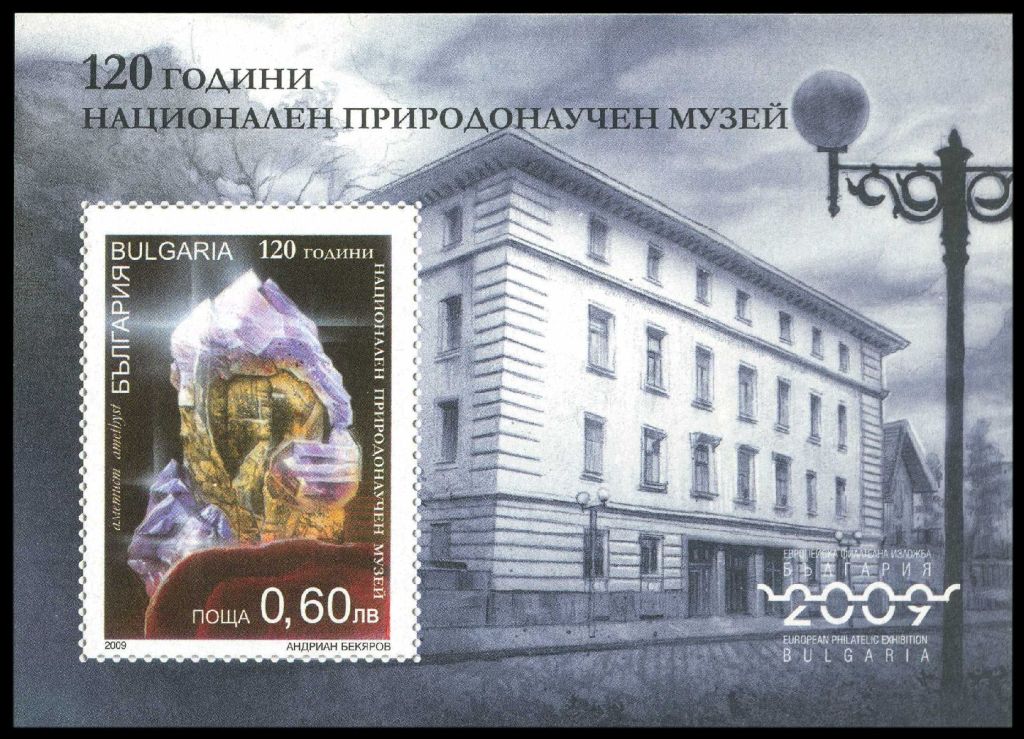
|

|
| The National Museum of Natural History of Bulgaria on margin of "120th anniversary of National Museum of Natural History" Souvenir Block of Bulgaria 2009. | Deinotherium giganteum depicted on illustration of official FDC and postal stationery |
A wall poster presents interesting information about the ammonites, a group of mollusks which are among the most abundant and beautiful of all fossils. One of the most attractive specimens is the giant ammonite from the Upper Santonian of Shumen Region — Parapuzosia sp., with diameters up to 144 cm!
Its age is estimated to be about 84 million years. This is the largest invertebrate fossil ever found in Bulgaria.
Some fossil mammals are also exhibited here. Most interesting of these fossils include the first (and so far, only) skull o of the giant deer (Megaloceros giganteus), the latest representatives of the European Bison (Bison bonasus), and a fossil tooth from Bulgaria of the gompthotheriid Anancus avernensis (Proboscidea). [R11]
Known Philatelic items (unfortunately, none of them show any fossils from the collection of the Museum):
- commemorative Souvenir Block "120th anniversary of National Museum of Natural History" of Bulgaria 2009, MiNr.: , Scott: . The stamp in the block shows a mineral. Fossil of Deinotherium giganteum is depicted on the official FDC and postal stationary.
Canada
The Royal Ontario Museum
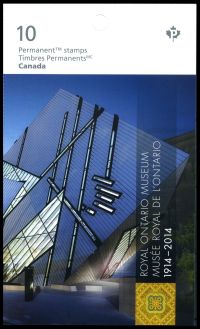
|
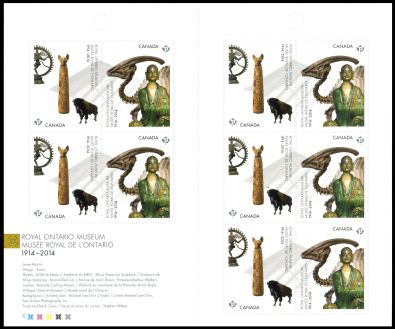
|
| Building of the Royal Ontario Museum on the cover and a skeleton of the dinosaur Parasaurolophus form the collection of the Museum on self-adhesive stamps of Canada 2014. | |
It is one of the largest museums in North America, attracting over one million visitors every year.
Established on April 16, 1912 and opened on March 19th, 1914, the museum has maintained close relations with the University of Toronto throughout its history, often sharing expertise and resources.
The museum contains a collection of dinosaurs, minerals and meteorites; Canadian and European historical artifacts; a s well as African, Near Eastern, and East Asian art.
It also houses the world's largest collection of fossils from the Burgess Shale with more than 150,000 specimens.
The Natural history galleries are all gathered on the second floor of the museum. The gallery contains collections and samples of various animals such as bats, birds, and dinosaur bones and skeletons.
Specimens represent life during the Jurassic and Cretaceous periods, grouped within the themes: Life on Land, Life on Sea, and Life in the Air.
The dinosaurs collection including Tyrannosaurus rex, Stegosaurus, Triceratops, the famous hadrosaur Parasaurolophus and many more. [R12]
Known Philatelic items:
- set of two stamps, mint and self-adhesive, "100th anniversary of the Royal Ontario Museum" of Canada 2014. Skeleton of the dinosaur Parasaurolophus was depicted on one of these stamps: Mint/Self-adhesive stamp: MiNr.: Bl. 187/3094 Scott: 2724/2724b.
Canada
Royal Tyrrell Museum of Paleontology
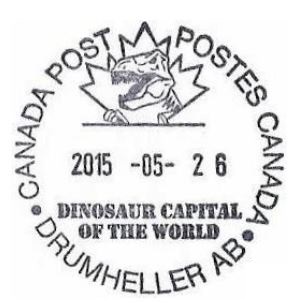
 The museum is a Canadian tourist attraction and a centre of palaeontological research noted for
its collection of more than 130,000 fossils and located only 6 kilometers away from the city of Drumheller.
The museum is a Canadian tourist attraction and a centre of palaeontological research noted for
its collection of more than 130,000 fossils and located only 6 kilometers away from the city of Drumheller. During the late Cretaceous period, 75 million years ago, the landscape was very different. The climate was subtropical, with lush forests covering a coastal plain. Rivers flowed east, across the plain into the Bearpaw warm inland sea. The low swampy country was home to a variety of animals, including dinosaurs. The conditions were also perfect for the preservation of their bones as fossils. Since digging began in the 1880s, more than 300 dinosaur skeletons have been pulled from a 27-kilometre stretch along the Red Deer River. [R13]
Known Philatelic items:
- meter franking "Tyrrell Museum of Paleontology" (see above) of Canada from 1980s-1990s.
- postmarks of the city of Drumheller. This postmark was first used in 2001 and then replaced by a slightly different design in 2015 (see above).
Chile
Chilean National Museum of Natural History, has twelve permanent exhibits.
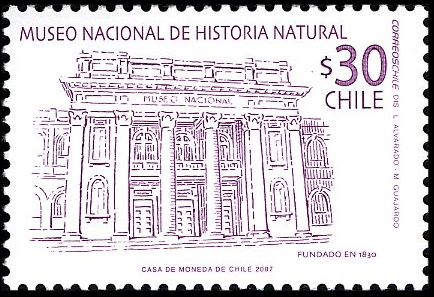
|
| The National Museum of Natural History on stamp of Chile 2007, MiNr.: 2187 Scott: 1480 |
The museum has five departments including botany, zoology, entomology, anthropology, and paleontology.
Claudio Guy, founder of the Museum, is shown on the right stamp of the strip from 1980.
The building of the Museum shown on stamp with face value of 30 peso from the Museums set in 2007. [R15]
Known Philatelic items:
- stamps set "The 150th Anniversary of National History Museum" of Chile 1980. One of the stamps shows Claudio Guy, the founder of the museum, MiNr.: 937, Scott: 576.
- stamp from "Museums in Santiago" set, show the museum, MiNr.: 2187 Scott: 1480.
China
The Beijing Museum of Natural History, is a museum located in Dongcheng District, Beijing, People's Republic of China.
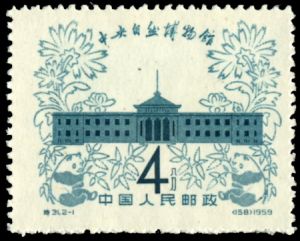 |
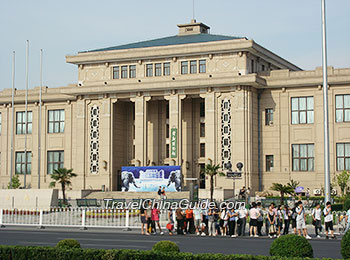 |
|
| The Beijing Museum of Natural History on stamp of China 1959 on the left and photo of the museum on the right. The image credit: travelchinaguide.com | ||
Its predecessor was the "Central Nature Museum", which was established in 1951 and was renamed to its current name in 1962.
With a total area of 24,000 square meters and an exhibition room of 8,000 square meters, it is one of the largest natural history museums in China.
There are about 200,000 items in the collection, of which 20% are on permanent display.
The exhibits are broadly divided into four categories: paleontology, plants, animals and humans.
The collections of Beijing Museum of Natural History include many extremely rare specimens: The world-famous skull of Stegodon zdanskyi, 26-meter-long Mamenchisaurus jingyanensis and the unique mummy fossil of dinosaurs in China.
The permanent exhibitions in the Beijing Museum of Natural History are mainly arranged according to the evolutionary trend of organisms, showing the Bio-diversity and its relationships with the environments and establishing a panorama of the emergence and development of the life on Earth. [R14]
Known Philatelic items:
- stamps set "Opening of the Natural History Museum, Peking (Beijing)" of China 1959, MiNr.: 435-436, Scott: 407-408.
China Dinosaurs Park in Changzhou,
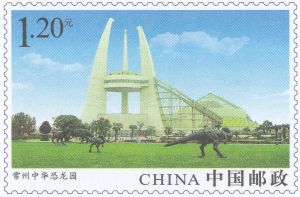
Imprinted stamp from Chinese postal stationery 2007. 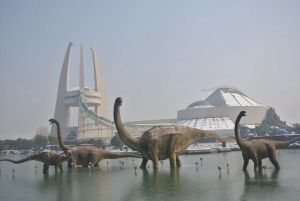 Image credit: Theme Park Tourist. |
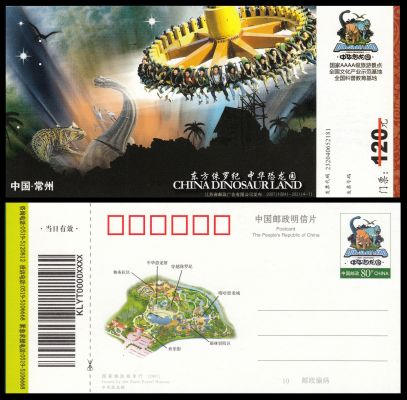
|
| Life size dinosaur sculptures at Dinosaurs Park in Changzhou. | Postcard entrance-ticket of Dinosaurs Park in Changzhou. |
The entertainment park covering an area of 100 hectares, is a tourism landmark of East China specially created by the professional Dragon City Tourism Holding Group in 2000. As it is a theme park about dinosaurs, it is also called the "Eastern Jurassic Park".
On top of many attractions, there is park with life size dinosaur sculptures and a museum.
The museum covers about 20,000 square meters and contains more than ten halls.
The museum displays 36 skeletal remains including a nearly complete fossil skeleton of the important dinosaur genus Sinosauropteryx as well as large fossils such as those of a Brachiosaurus and a Hadrosaurus.
In addition, there are a lot of amusing high-fidelity game facilities. All the games are related to prehistoric animals, such as "Pterodactyl's movement" and "Hot dance of the dinosaur car". [R17]
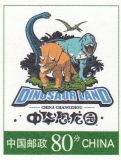 |
Logo of the DINOLAND park in Changzhou on imprinted stamp of China, used on some postal stationeries since 2007. |
In 2007 State Post Bureau of China issued several postal stationeries (pre-stamped post cards and pre-stamped commemorative envelope) with title "China Dinosaur Land park in Changzhou".
Both, imprinted stamp and illustration (cachet) of the pre-stamped envelope (C5 size) shows the entrance of the park with models of some dinosaurs in the front.
Imprinted stamp on postcard attached to entrance ticket of China Dinosaur land theme park at Changzhou shows four very recognizable prehistoric animals including three dinosaurs: (Tyrannosaurus, Triceratops, Brachiosaurus) and pterosaur Pteranodon.
At least five varieties of this postcard were issued with the same stamp. The same design was used for one of the postmarks issued in 2017 on the same date as the Chinese Dinosaur stamps above.
Known Philatelic items:
- Postal stationery of China 2007 with dinosaur sculptures in the park.
- Imprinted stamp with the logo of the park in introduced by Chinese post in 2007.
- China Dinosaur Land Park at Changzhou on postmark of China 2007.
China The Tianjin Natural History Museum, the museum located at the west end of Machang Road, was set up in 1914 by a French missionary and opened in 1927, with the previous name of Beijiang Museum. It acquired the present name in 1957.
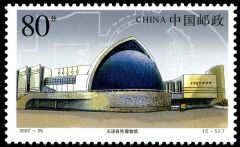 |
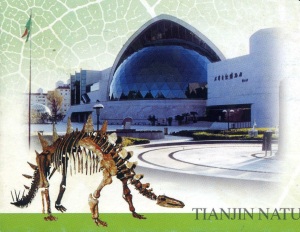
|
|
| The Tianjin Natural History Museum on stamp and FDC illustration of China 2002 | ||
The collections include over 380,000 specimens and key collections cover the paleontology of the late period of the Chinese Cenozoic.
These Cenozoic fossils include ancient mammals excavated from the Yushe Basin of Shanxi Province, the Qingyang Basin of the Gansu Province, the Yang Yuanni Basin of the Hebei Province, and from Inner Mongolia.
As specimens of these animals are rare outside of China, the collections of the Tianjin Natural History Museum are an important collection for the study of these organisms.
The museum has 4 major exhibits – with displays on Animals, Paleontology, Plants and Paleoanthropology.
Other fossils on display include ancient reptiles and mammals, insects and aquatic organisms. [R3]
Known Philatelic items:
- stamp from "Museums of China" set of China 2002
China
Xixia Dinosaur Relics Park, is located in Nanyang City, in Xixia County of the Henan Province, People’s Republic of China. This park is famous for its collection of dinosaur egg fossils – which have been dubbed the world’s ninth wonder following the “terra cotta warriors and horses from Emperor Qin Shihuang’s Mausoleum”.
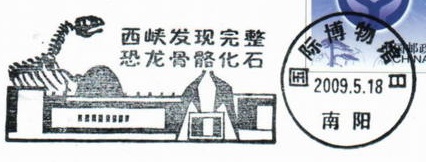 Entrance of Xixia Dinosaur Relics Park on "Nanyang world museum day" postmark of China 2009. Image credit for the photo on the right: china.org.cn |
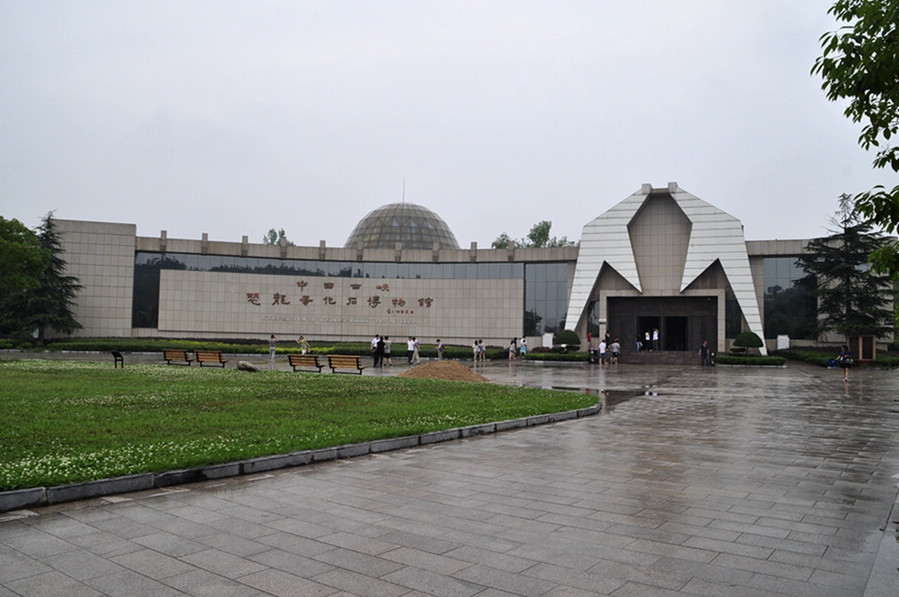 |
Two rare egg species from the site were named Macroelongatoolithus xixiaaensis and Prismatoolithus gebiensis.
- Macroelongatoolithus xixiaaensis - is an oogenus (a type of trace fossil given a specialized genus name representing that it is a fossil egg) of large, fossil theropod eggs. These eggs are most notable for their large size of 34 - 60 centimetres long. They are also very elongated, usually roughly three times longer than they are wide. These eggs are often found in large clutches of up to 26 eggs, with the eggs forming a ring 2–3.3 metres in diameter, their shell is typically between 1.38 mm and 4.75 mm thick.
- Prismatoolithus gebiensis is an oogenus from the Cretaceous.
These eggs, about 8 cm long and roughly ovular in shape.
The Prismatoolithid eggs are attributed to non-avian theropods on the basis of the discovery of this type of eggs with embryos of the troodontid Troodon formosus from the Two Medicine Formation in Montana, USA, and on the basis of the considerable resemblances with some avian eggshells.
In 1994 the remains of Nanyangosaurus were found near the village of Houzhuang, in Neixiang county in Henan. This dinosaur is a genus of herbivorous ornithischian dinosaur and is a basal member of the Iguanodontia that lived in the Late Cretaceous of present-day Henan Province, China.
Nanyangosaurus was a relatively small dinosaur with an estimated length of four to five metres. [R19]
Known Philatelic items:
- "Xixia Dinosaur Relics Park" postmark of China 2007
- "Nanyang world museum day" postmark of China 2009 (see above), similar design as the postmark from 2007, but with dinosaur fossil on the left.
- "Dinosaur's eggs and embryo from Nanyang province" postmark of China 2006
- "Fossil of Theropoda, Nanyang of Hena" postmark of China 2017
- "Xixia Dino Relics Park" postmark of China 2017
- "Nanyang city of Henan province" not pictorial postmark of China 2017
China
Zigong Dinosaur Museum, located 9km northeast of the center of Zigong city, Sichuan province in Southwest China.
It is a large museum which has been built at the world-famous “Dashanpu Dinosaur Fossil Group Site”, in Zigong UNESCO Global Geopark.
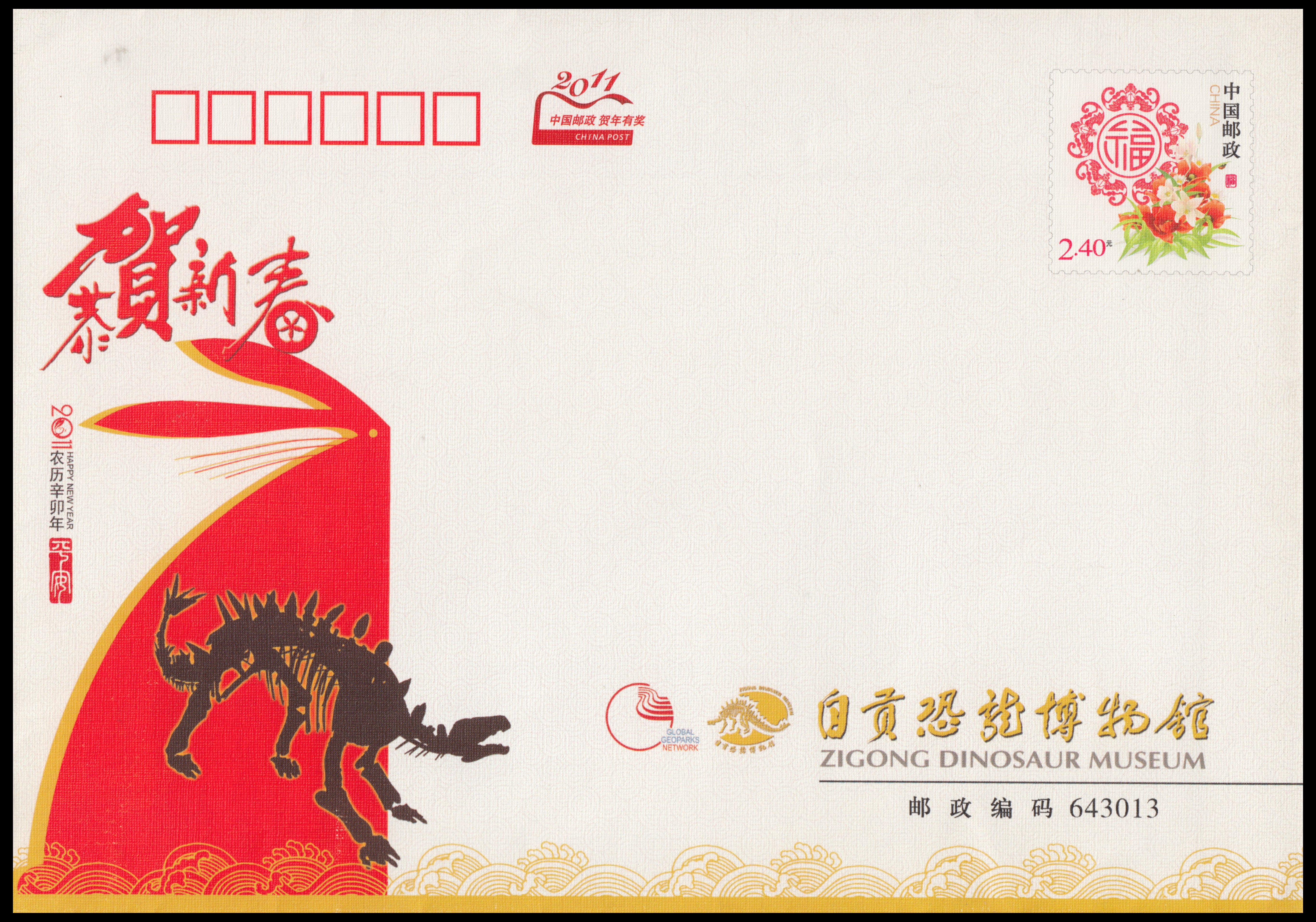 |
| Huayangosaurus taibaii one of the most primitive and complete stegosaur, from collection of Zigong Dinosaur Museum shown on the cachet of the postal stationery of China 2011. |
Zigong Dinosaur Museum was praised by the US “National Geographic” magazine as “The Best Dinosaur Museum in the World”.
Covering an area of over 70,000 m2, Zigong Dinosaur Museum has a collection of prehistoric animals, fishes, amphibians, mammals-like reptiles, mammals and of course dinosaurs.
The collection of the museum is based almost entirely on fossils discovered in Asia and it covers almost the entire Jurassic period (201-145 million years ago). [R16]
Some highlights of Zigong Dinosaur Museum are:
- The most primitive and complete stegosaur in the world – Huayangosaurus taibaii. This stegosaur was chosen for the Logo of the Museum and is shown on the cachet of the postal stationary.
- Skin impressions of Stegosaur and Mamenchisaurus sauropod dinosaurs. Both fossils were discovered in China.
- Dinosaur's eggs.
Known Philatelic items:
- postal stationery of China 2011 (see on the right)
- some dinosaurs from the collection of Zigong Dinosaur Museum were depicted on commemorative postmarks in 2014 and 2017 (the famous Stegosaur Huayangosaurus taibaii).
Costa Rica
The National Museum of Costa Rica
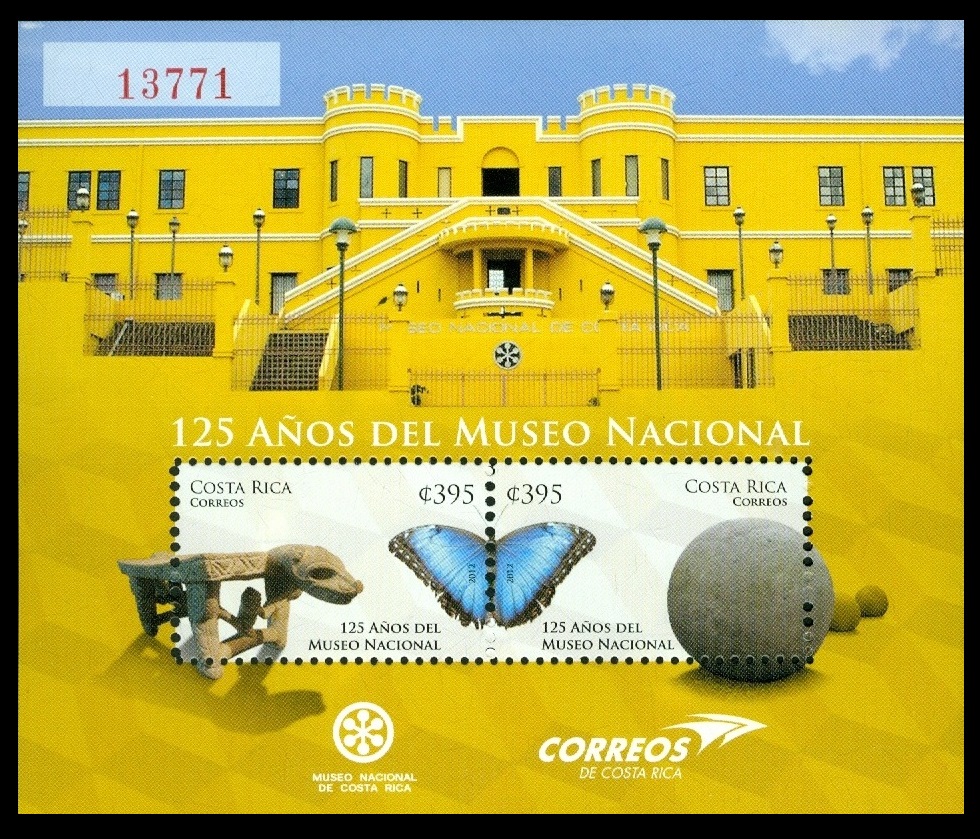 The National Museum was opened on May 4, 1887, under the presidency of Bernardo Soto.
Bernard Soto established a museum with the purpose of providing his country with a public
establishment where natural and artistic objects could be deposited, classified and studied.
The National Museum was opened on May 4, 1887, under the presidency of Bernardo Soto.
Bernard Soto established a museum with the purpose of providing his country with a public
establishment where natural and artistic objects could be deposited, classified and studied. The Natural History Department of the Museum has a large collection of fossils including over 9,000 specimens of sponges, corals, mollusks, echinoderms, vertebrates, plants and more.
This collection is the most important collection of fossil vertebrates in the country.
[R18]
Related stamps: Costa Rica 2012, MiNr.: Bl. 47, Scott: 647
Czech Republic
National Museum in Prague is the largest Czech museum.
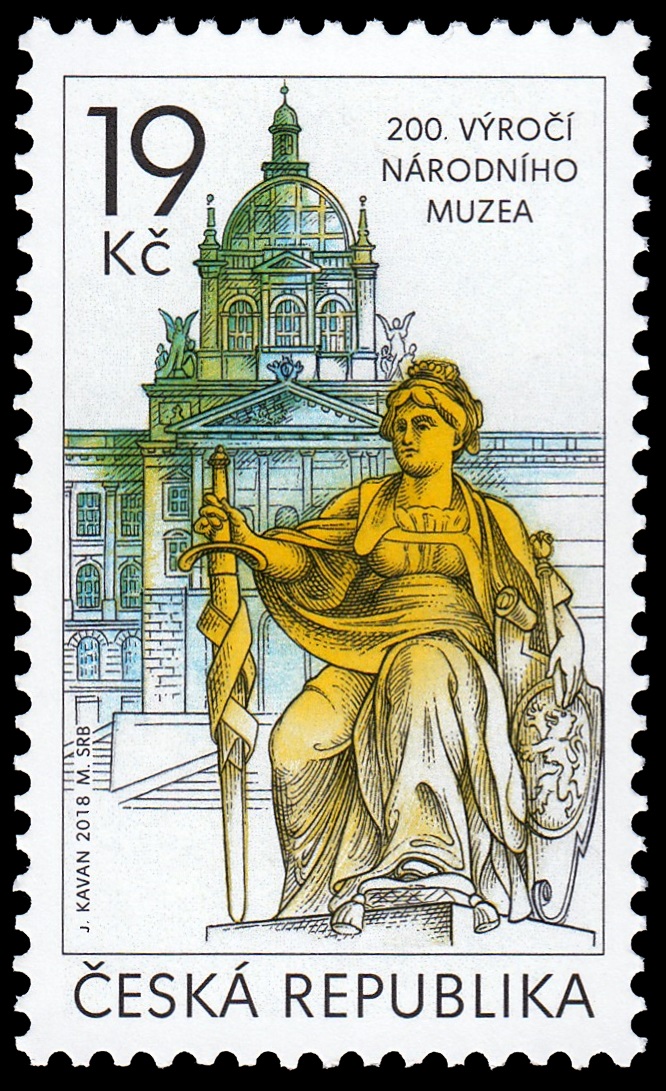 |
| The National Museum in Prague on stamps of Czech Republic 2018 MiNr.: 999, Scott: 3768. |
The paleontologic collection of the museum represent world milestones in the knowledge of the history of life on Earth, from the Paleozoic to the Quaternary.
The visitor of the museum get acquainted with the Paleozoic animals first described by Joachim Barrand, see the rare oldest terrestrial plant in the world, Cooksonia barrandei, which dates back to 430 million years ago.
The Mesozoic part of the exhbit contain the oldest known reptiles – for example the Mesozoic sea mosasaurs and only the Czech dinosaur Burianosaur augustai.
During this time, the territory of the Czech Republic was located much further south and the climate was subtropical.
A small life-size wooly mammoth next to its original skeleton, a furry rhino and the scary-looking saber-toothed tiger can be seen in the Quaternary part of the exhibit. [R20]
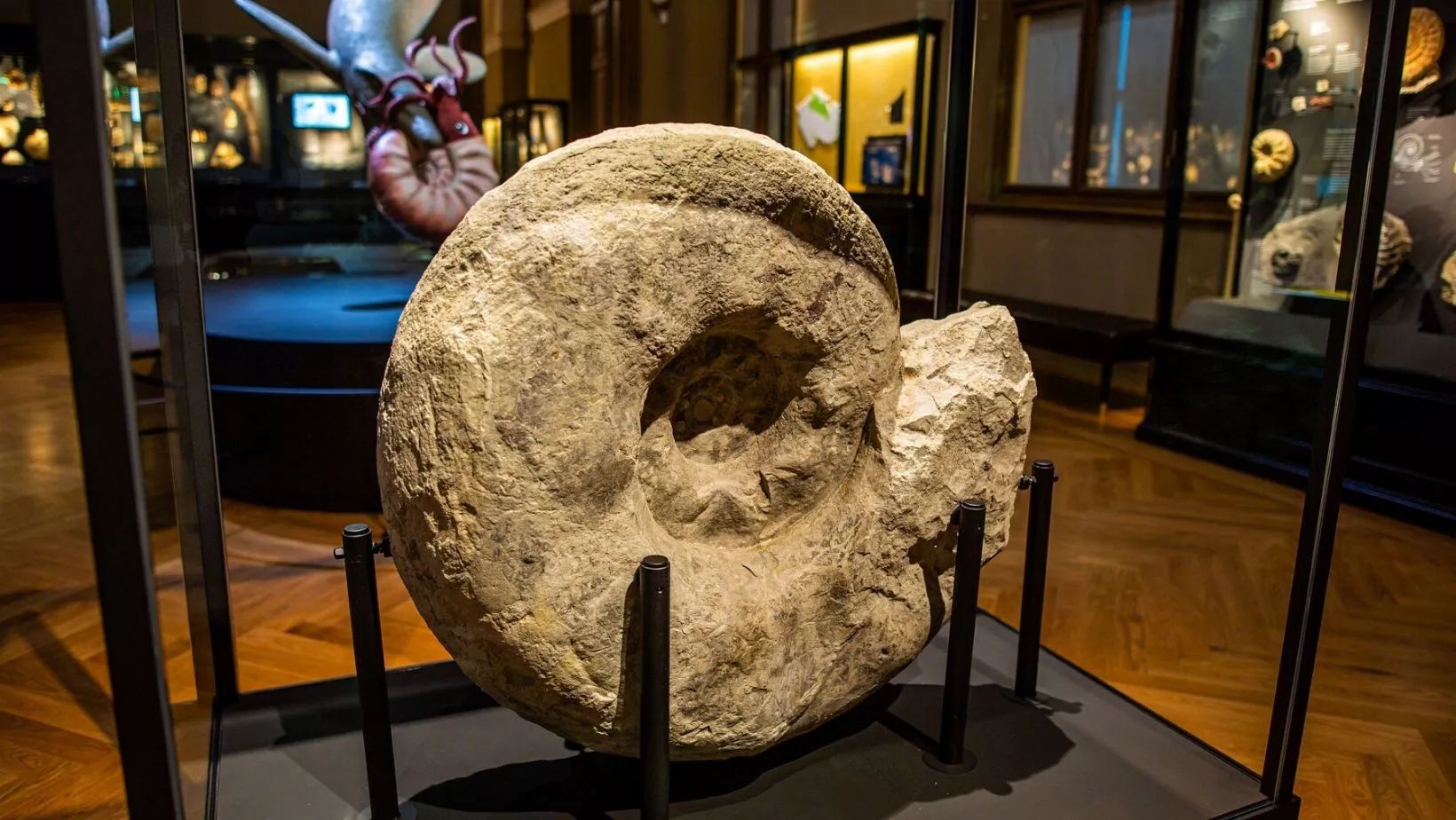 |
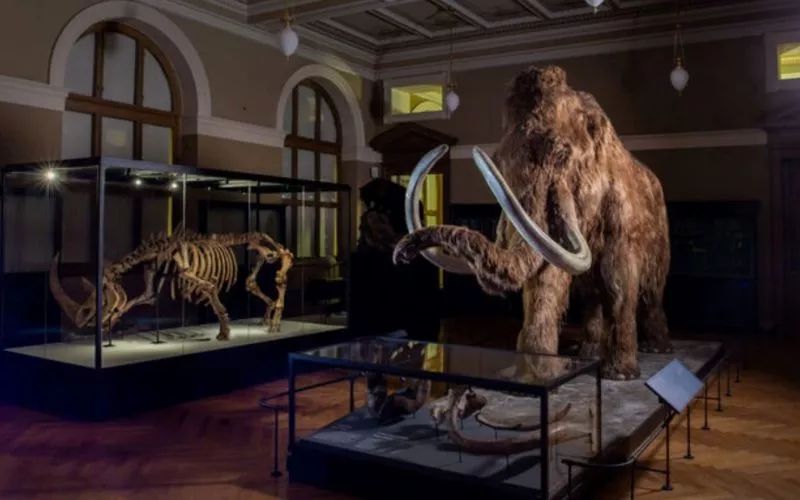 |
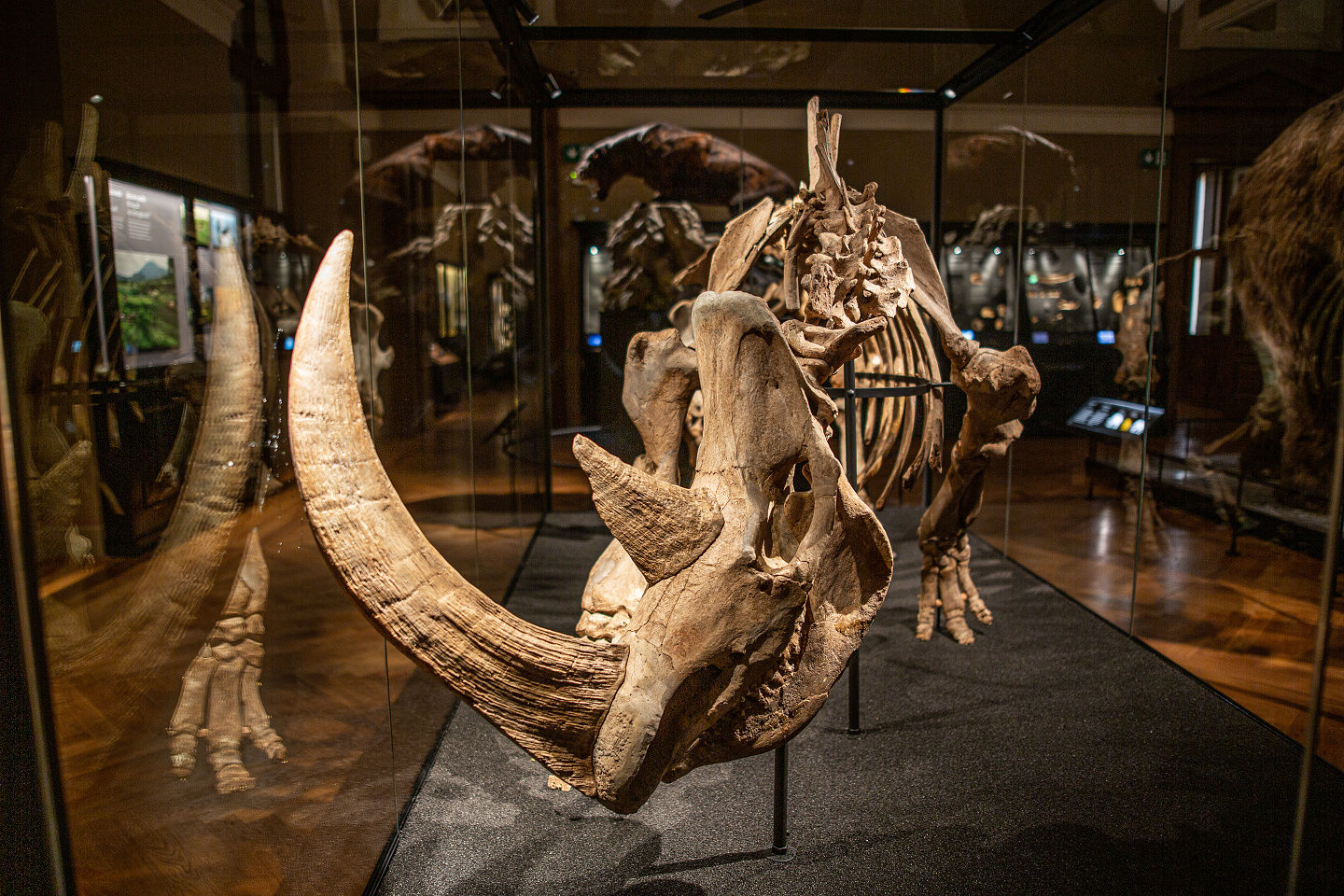 |
| Fossils from exhibit of the National Museum in Prague. Images credits: nm.cz | ||
Known Philatelic items:
- stamp "National Museum in Prague" of Czech Republic from 2018, MiNr.: 999, Scott: 3768 (see above).
The Dominican Republic
The National Museum Of Natural History Prof. Eugenio De Jesús Marcano
located in the Plaza de la Cultura Juan Pablo Duarte in Santo Domingo, Dominican Republic, built by Dr. Joaquín Balaguer in 1974 and opened its doors to the public in 1982.
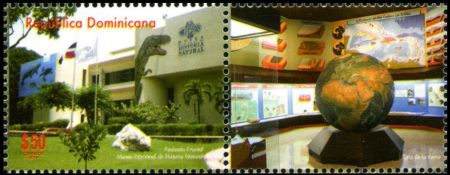 |
| The building of Natural History Museum of the Dominican Republic on International Museum Day stamp of the Dominican Republic from 2014, MiNr: 2359, Scott 1556a. |
It is a state institution created for the purpose of conserving the biodiversity of the Caribbean region and studying it.
This museum has the largest scientific collection of fauna in the country with more than one hundred and thirty thousand specimens of vertebrates and invertebrates.
The Museum is tasked with the mission to contribute to the preservation of biodiversity on the island of Hispaniola and the Insular Caribbean and provide knowledge and awareness about biodiversity topics to the community.
The museum was named after Prof. Eugenio de Jesús Marcano, by presidential decree on August 14, 2012, in recognition and honor of this distinguished naturalist, who was the first Scientific Director of the institution.
The goal of the museum is to carry out scientific research and maintain reference collections of fauna, geology and paleobiology, to contribute to the knowledge and sustainable management of biodiversity and education for citizen appreciation of science. [R21]
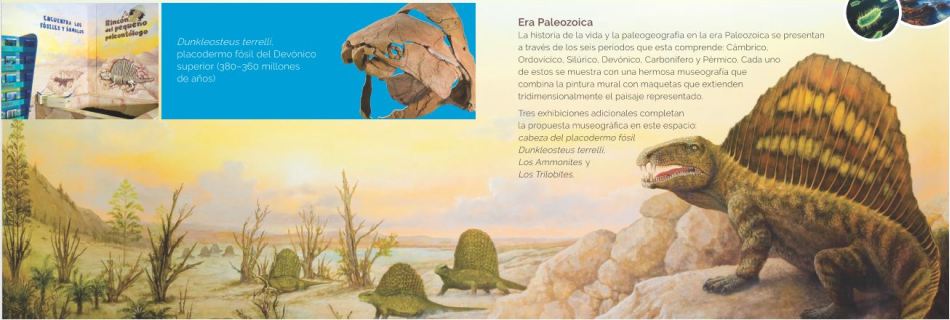 |
| Paleozoic room in the Natural History Museum of the Dominican Republic. |
Known Philatelic items:
- One of the Mini-Sheets "World Museum Day 2014: Collections create connections" of the Dominican Republic from 2014, MiNr.: Bl. 70, Scott: (see above).
Egypt
The Egyptian Geological Museum is a museum in Cairo, Egypt.
The museum was established in 1904 as part of the Egyptian Geological Survey.
The Egyptian Geological Survey was established in 1896 under the direction of the Khedive Ismail.
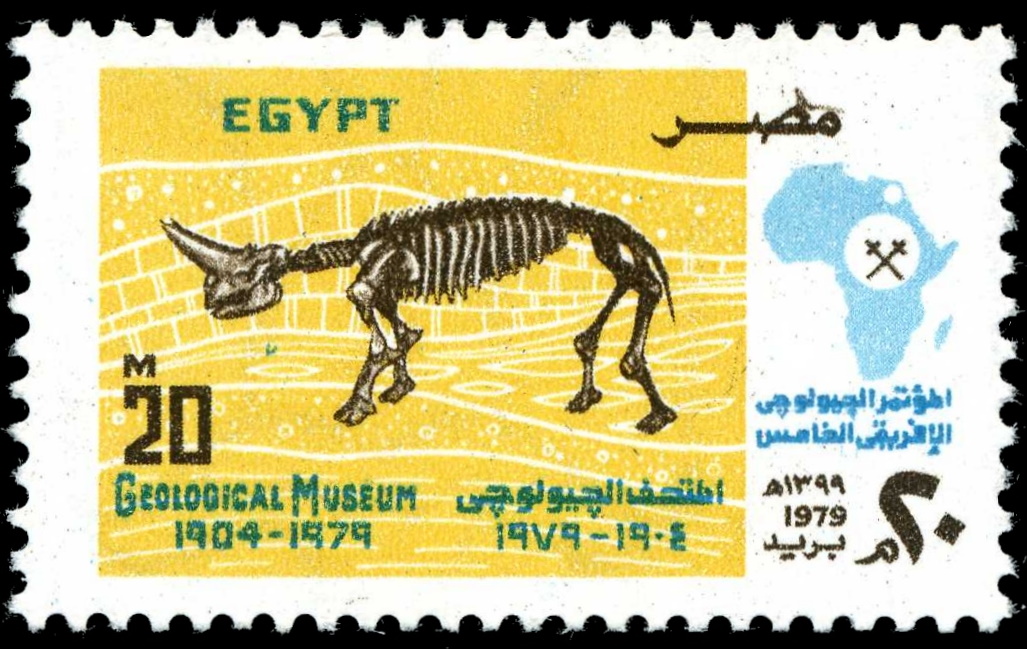 |
| Arsinoitherium zitteli skeleton on stamp of Egypt 1979 MiNr.: 1323, Scott: 1114. |
The museum was initially housed in a Greco-Roman style building that was located in the gardens of the Ministry of Public Works in downtown Cairo; it was designed by Marcel Dourgnon, the French architect who had previously designed and constructed the Egyptian Museum (also known as the Museum of Egyptian Antiquities).
This building had an exhibition hall with ceilings 4 metres high in order to accommodate the reconstructed fossil skeletons of paleontological finds, which included a 3 metres high ancestral elephant.
One of the fossils, the skeleton of Arsinoitherium zitteli was depicted on a Egyptian stamp in 1979.
Arsinoitherium is an extinct genus of paenungulate mammals belonging to the extinct order Embrithopoda.
Arsinoitheres were superficially rhinoceros-like herbivores that lived during the Late Eocene and the Early Oligocene
of North Africa from 36 to 30 million years ago, in areas of tropical rainforest and at the margin of mangrove swamps.
The species, Arsinoitherium zitteli, was named in honor of the eminent German paleontologist Karl Alfred Ritter von Zittel,
who was a pioneer of paleontology in Egypt.
The original museum was expanded in 1968 with the construction of an annex designed to house the museum's laboratories for petrology and paleontology.
The museum remained there in downtown Cairo until 1982, when the original building was torn down to accommodate construction of the Cairo Metro and the museum was transferred to its present location near Maadi, a southern suburb of Cairo. [R22]
Known Philatelic items:
- stamp "100th anniversary of Egyptian Geological Museum" of the Egypt from 1979, MiNr.: 1323, Scott: 1114.
El Salvador
Natural History Museum of El Salvador (MUHNES)
The museum was founded in 1883 during the tenure of President Rafael Zaldívar, to display the national collections related to archaeology, history and fine arts.
Its founder and the first director was a naturalist and archaeologist David Joaquín Guzmán.
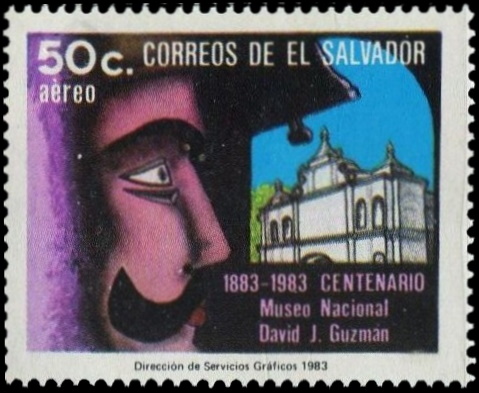 |
| Guzman National Museum on stamp of El Salvador 1983 MiNr.: 1480, Scott: 974. |
In 1875, David J. Guzman and Darío González organized an expedition to investigate the geology of
sediments of the Los Frailes River, southwest of Ilobasco.
During this exploration, they discovered
fossils of Mastodon (Gomphotherium).
In 1927 the museum moved into premises in a former military hospital.
In 1941, the museum was split into Anthropologic and Natural Sciences museums.
The Anthropologic museum was renamed the David J. Guzman National Museum in honor of the founder, in 1945.
The Natural Science Museum was renamed to the Natural History Museum of El Salvador (MUHNES), in 1976.
The Natural History Museum of El Salvador is a scientific institution whose purpose is to investigate the biological and paleontological diversity of the country, manage the National Natural History Collections, as well as transmit and share knowledge about Salvadoran natural heritage.
The Paleontological collection of the museum shows some artifacts from El Salvador and neighboring countries. During the Mesozoic, some marine limestones were deposited in El Salvador - unfortunately, these do not have dinosaur fossils. Most of El Salvador's geology formed during the Cenozoic after the dinosaurs had died out and the fossil record of El Salvador is dominated by prehistoric mammals.
Many fossils of prehistoric mammals, including 9-million-year-old teeth belonging to mastodons, an extinct group of large mammals related to elephants, are on the show in the Natural History Museum of El Salvador.
Some fossils and reconstructions of prehistoric animals from collection of the museum were depicted on postage stamps of El Salvador in 1979 and 2006. [R23]
Known Philatelic items:
- stamps set "100th anniversary of Guzman National Museum" of El Salvador from 1983, MiNr.: 1479-1480, Scott: 973-974.
- stamps set "Prehistoric Fauna from El Salvador" of El Salvador from 1983, shows reconstructions of 6 prehistoric animals from collection of Guzman National Museum, MiNr.: 1289-1294, Scott: 911-913, C458-C460.
France: National Museum of Natural History, Paris
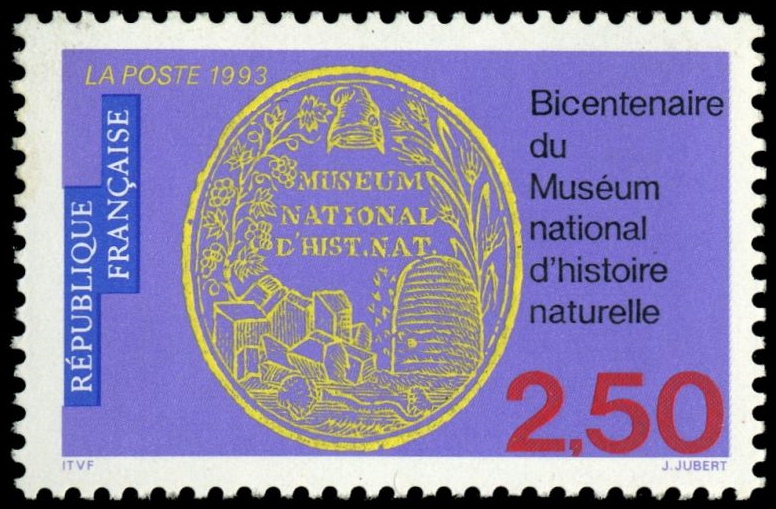 |
| The seal of the National Museum of Natural History of France on stamp of France 1983 on stamp France from 1983. |
The main museum, with four galleries, is located in Paris, France, within the Jardin des Plantes on the left bank of the River Seine.
The museum was formally established on June 10, 1793, by the French Convention, the government during the French Revolution, at the same time that it established the Louvre Museum.
But its origins went back much further, to the Royal Garden of Medicinal Plants, which was created by King Louis XIII in 1635, and was directed and run by the royal physicians.
Some of its early professors included:
- Georges-Louis Leclerc, Comte de Buffon, one of the leading naturalists of the Enlightenment. His statue is prominently placed in front of the Gallery of Evolution and shown on the margin of the personalized Souvenir Sheet "89th Congress of the French Federation of Philatelic Associations (FFAP)" .
- Eminent comparative anatomist Georges Cuvier, often referred to as the "founding father of paleontology".
- The pioneers of the theory of evolution Jean-Baptiste de Lamarck
As its collections grew, the museum was enlarged, with the construction of a new gallery of zoology. It was begun in 1877 and completed in 1889, for the 100th anniversary of the French Revolution.
A new gallery of paleontology and comparative anatomy was opened in 1897.
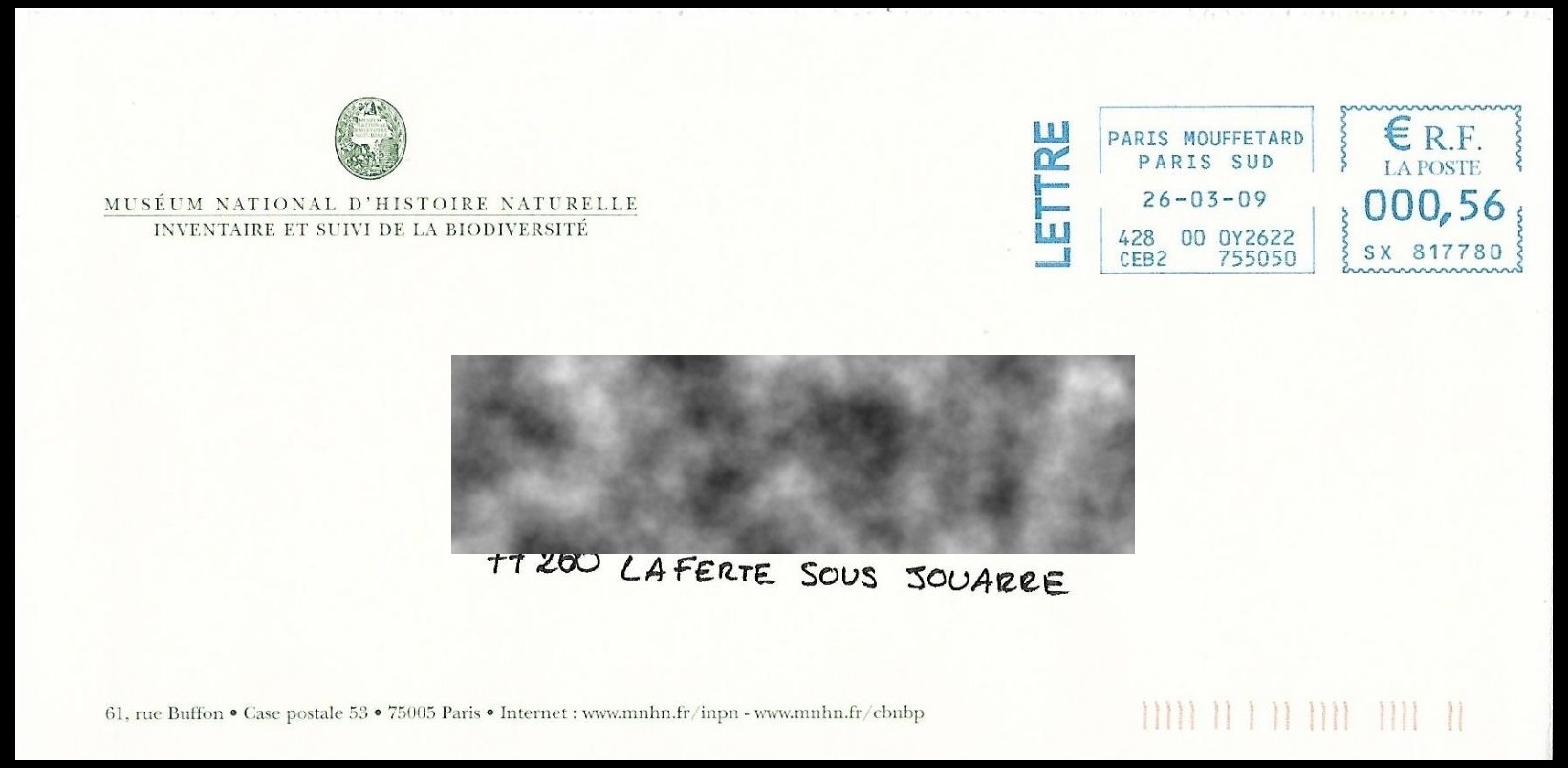 |
| A cover of the National Museum of Natural History of France, 2009. |
The museum now has 14 sites throughout France. The birthplace of the museum and a large part of its modern collections are found in five galleries in the Jardin des Plantes, in Paris.
The Gallery of Paleontology and Comparative Anatomy (in French, Galerie de Paléontologie et d'Anatomie comparée) is situated in the Jardin des Plantes in Paris near the Gare d'Austerlitz.
The Gallery of Comparative Anatomy (occupying the ground floor), holds nearly a thousand skeletons and interprets their organization and classification.
The Gallery of Paleontology (occupying the first and second floor) hosts a famous collection of fossil vertebrates, fossil invertebrates and fossil plants.
Among the pieces most appreciated by the public are a series of casts of dinosaur skeletons such as Diplodocus, Iguanodon, Allosaurus, Carnotaurus, Tarbosaurus, skulls of Tyrannosaurus and Triceratops.
Several important prehistoric mammal skeletons are also on display including Mammuthus, Megatherium, the Cave Bear, and many others.
The skeleton and reconstruction of Allosaurus were depicted on a French stamp from 2000. [R24]
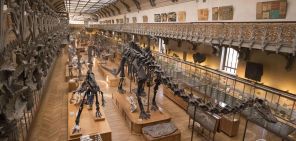 |
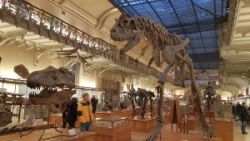 |
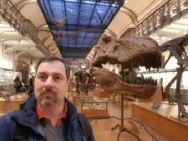 |
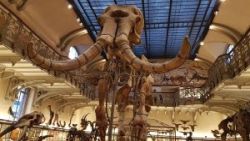 |
|
Fossils from collection of the National Museum of Natural History in Paris, France. Image credits: the photo on the left is from the website of the Museum. Another three photos were taken by admin of this site, Mr. Michael Kogan, in January 2020. |
|||
Known Philatelic items:
- stamp and postmark "Bicentennial Museum of Natural History" of France from 1993, MiNr.: 2958, Scott: 2363 (see above).
- meter franking with the logo of the museum of France 1998
- stamp "Тhe National Museum of Natural History" of France from 2000, MiNr.: Bl. 23, Scott: 2779.
- personalized stamp "89th Congress of the FFAP" of France from 2016.
France: Museum of Lodeve (Musee Fleury)
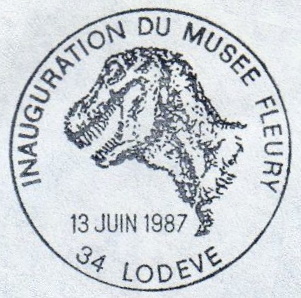 |
| Dinosaur on inaguration of Fluery Museum in Lodeve on postmark France from 1987. |
It is thus possible to follow the flow of the comings and goings of the sea, the movement of the continents, climate changes, the activity of volcanoes.
Each room plunges you into a geological period – Carboniferous, Permian, Triassic, Jurassic, Miocene – with its landscapes, animals and plants.
Multimedia makes it possible to understand the formation of continents, the evolution of species or even the work of researchers. [R25]
Known Philatelic items:
- the postmark of France 1987 (see above)
- the postmark of France 1993-1997
France: Savigneen Museum (Le Musee du Savigneen)
is small museum in Savigné-sur-Lathan town in the North-West of France.
The Savignéen museum invites its visitors to return to the time of the legendary "Sea of the faluns" dating back 15 million years.
 |
| Savigneen Museum in Faluns on postmark of France from 1996. |
The Sea of Faluns is an ancient sea that has now disappeared and which covered the West of France
around 16 to 3.5 millions of years ago.
It stretched from Normandy to Vienne (French department in the West of France, don't mix it with
the capital of Austria), forming an arm of the sea passing through Brittany, Anjou,
Touraine and Blésois.
After its withdrawal it leaved behind a rock rich in shell debris called the falun.
It therefore owes its name to this sedimentary rock known to be extremely rich in fossils
The museum was opened in 1973, in the guard tower of the Porte de Courcelles, defensive element of the fortifications of Savigné, dating from the 16th century.
The aim of the Museum is acquiring, maintaining and presenting collections of fossils discovered in the Faluns basin of Savigneen as well as all the objects, tools and materials that have contributed to the life of the population. [R26]
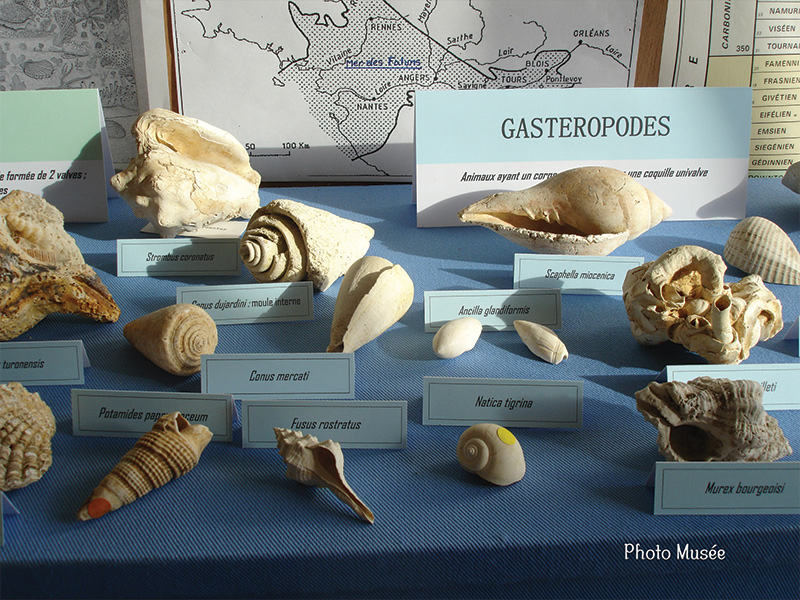 |
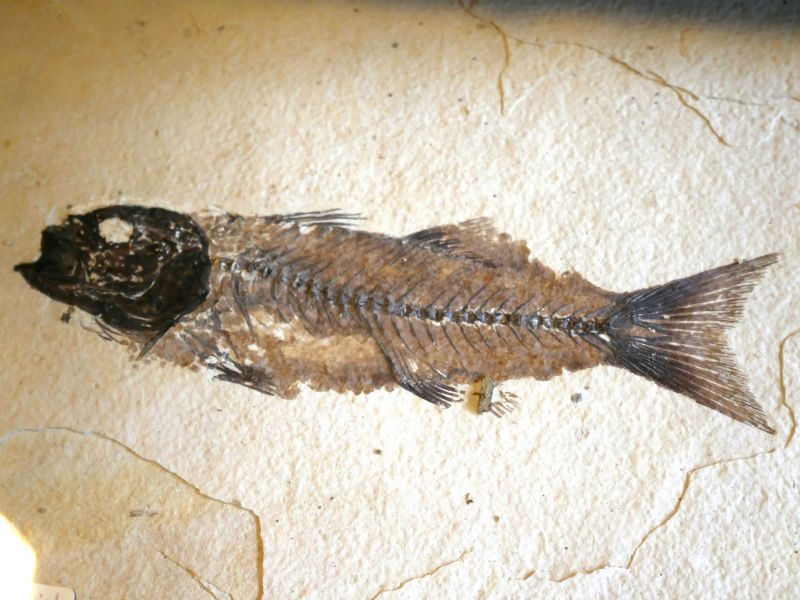 |
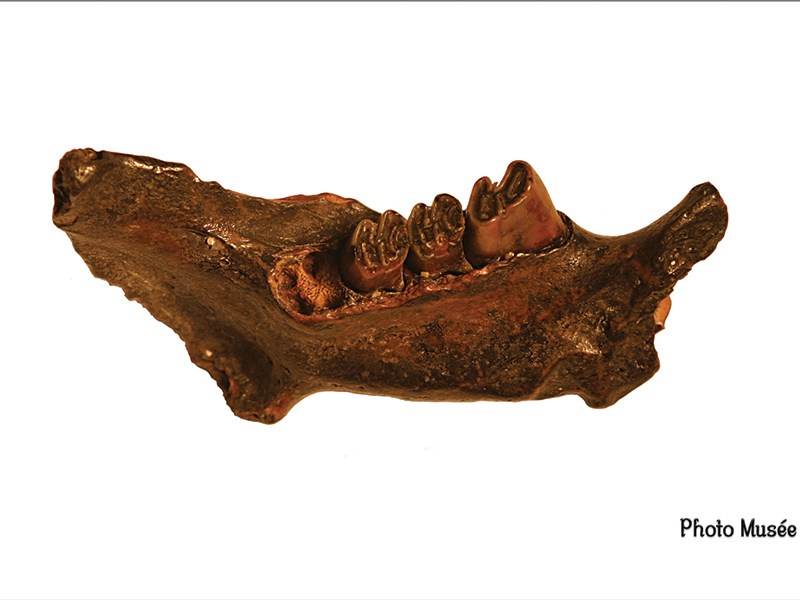 |
| Some fossils from collection of Savigneen Museum. Images credit: touraineloirevalley. | ||
Known Philatelic items:
- the postmark of France 1996-2006 (see above)
- some personalized postal stationeries of France
France: Dinosaur museum in Esperaza
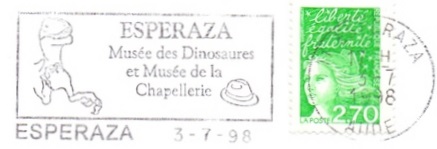 |
| Dinosaur museum in Esperaza on postmark of France from 1998-2000. |
In 1992, the Dinosaur Museum was opened near the excavation site.
The museum have over three dozen of dinosaur species on the display. The most complete dinosaur skeleton in collection of the museum and the most complete dinosaur skeleton ever found in France, is Ampelosaurus.
The specimen was discovered in August 2001 by Eva Morvan, a geology student who provided the nickname "Eva".
The dinosaur is estimated be around 12 meters long, 2.5 meters tall and weighing 10-15 metric tons. It appears to be juvenile, as some adult bones found in the area are about twice as large.
This Dinosaur Hall of the Museum offers a walk around dinosaurs and other reptiles originating from the four corners of the globe, some of which are presented for the first time in France or Europe: Tsintaosaurus, Tuojiangosaurus, Mamenchisaurus, as well as the skull of a Triceratops and the gigantic reptile flying Quetzalocoatlus. [R27]
Quetzalocoatlus is the largest flying reptile of all time, with wingspan of 12 meter.
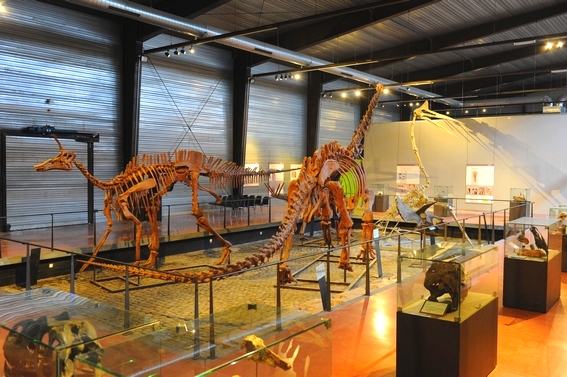 |
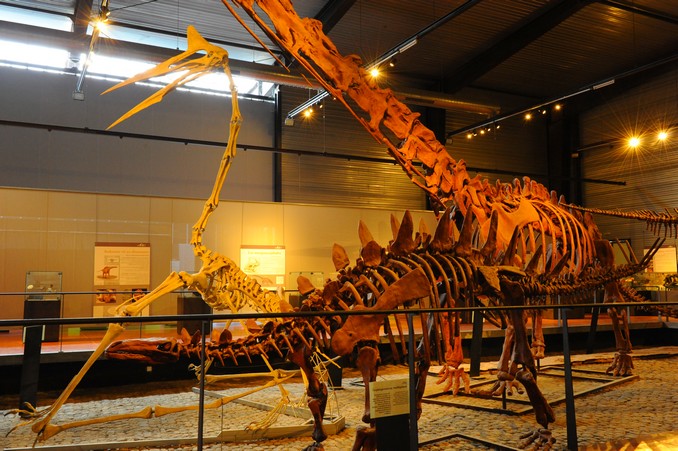 |
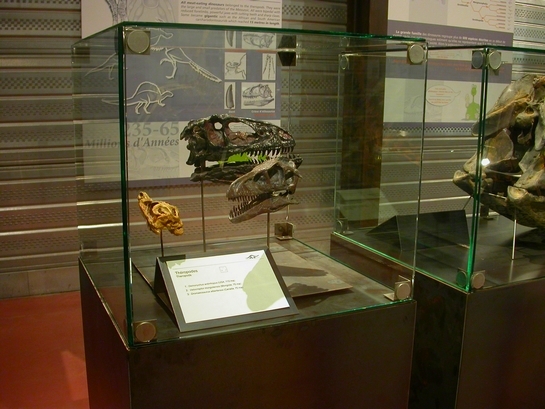 |
| Dinosaurs and Quetzalocoatlus skeletons and skulls in the Dinosaur's Hall of the Esperaza Dinosaur Museum. Images credit: official website of the Esperaza Dinosaur Museum. | ||
Known Philatelic items:
- the postmark of France 1996-2006 (see above)
- some personalized postal stationeries of France
France: Natural History Museum of Reunion
Réunion is an island in the Indian Ocean that is an overseas department and region of France. It is located approximately 550 km east of the island of Madagascar and 175 km southwest of the island of Mauritius.
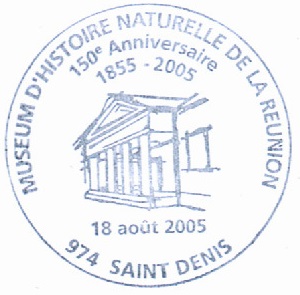 |
| Natural History Museum of Reunion on postmark of France 2005. |
At the heart of the State Garden is the Natural History Museum. It occupies the premises of the Legislative Palace, built in 1834 to house the Colonial Council until 1848. It became a Museum in 1855.
It houses a collection of current and extinct fauna from the islands of the western Indian Ocean (Reunion, Madagascar, the Seychelles, etc.)
The Museum also has a very rich old library, since it contains quite rare original editions such as those of the work of Spallanzani, Réaumur, Lacépède and works of great value such as the complete works of Linné, Buffon, de Cuvier and de Grandidier on Madagascar.
Some display cases are devoted to the mechanisms of evolution, making it possible to explain the significant diversity and the high degree of endemism of the Malagasy fauna: to be particularly noted is the second display, which highlights scene of birds of the Vangidae family with beaks all different from each other.
Its objective is to introduce the visitor to the concept of adaptive radiation and evolution which is generally explained in the works from the historical observation of the finches of the Galapagos made by Charles Darwin. [R28]
Known Philatelic items:
- the postmark "150th anniversary of Natural History Museum of Reunion" of France 2005 (see above)
Germany: Museum of Natural Science in Berlin (Museum für Naturkunde in Berlin)
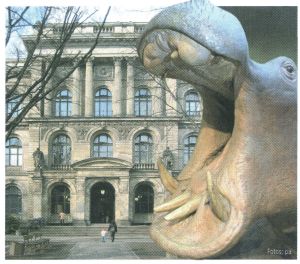
|
| Entrance of the Museum of Natural Science in Berlin, on the cachet of German FDC 2010. |
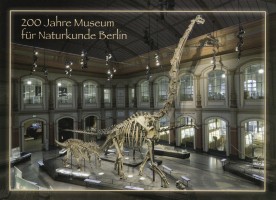
|
| Mounted skeleton of Giraffatitan in dinosaur hall of Natural History Museum in Berlin on post card of Germany 2010 |
It is one of the most important research institutions worldwide in the areas of biological and geological evolution and biodiversity.
The museum was founded in 1810 as a part of the Berlin University, which changed its name to Humboldt University of Berlin in 1949. For much of its history, the museum was known as the "Humboldt Museum", but in 2009 it left the university to join the Leibniz Association. The current official name is Museum für Naturkunde – Leibniz-Institut für Evolutions- und Biodiversitätsforschung. The collection of the museum is a unique natural and cultural asset, inextricably linked to our research and comprises over 30 million items covering zoology, palaeontology, geology and mineralogy and is of highest scientific and historical importance.
It is famous for two exhibits: the largest mounted dinosaur in the world (a Giraffatitan skeleton), which was depicted on German stamp in 2010, and a well-preserved specimen of the earliest known bird, Archaeopteryx which was depicted on German stamp in 2011. Expeditions to fossil beds in Tendaguru in former Deutsch Ostafrika (today Tanzania) between 1909 and 1913, unearthed rich paleontological treasures.
The collections are so extensive that less than 1 in 5000 specimens is exhibited, and they attract researchers from around the world. [R29]
Known Philatelic items:
Building of the Museum
- cachet of FDC "100th anniversary of Natural History Museum of Humboldt University in Berlin" German Democratic Republic (GDR) 1990
- cachet of FDC "Bicentenary of Museum fuer Naturkunde in Berlin", Germany 2010
- set of 6 stamps "Berlin Natural History Museum, Paleontologic collection", German Democratic Republic (GDR) 1973
- set of 5 stamps and Mini-Sheet of "100th anniversary of Natural History Museum of Humboldt University in Berlin", German Democratic Republic (GDR) 1990
- mint and self-adhesive stamps "Bicentenary of Museum fuer Naturkunde in Berlin", Germany 2010
- commemorative stamp "150 years of discovery prehistoric bird Archaeopteryx", Germany 2011
Germany: Museum of Natural Science in Chemnitz (Museum für Naturkunde in Chemnitz)
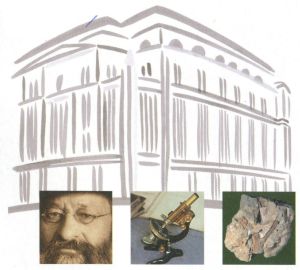
|
| The Museum of Natural Science in Chemnitz, on the cachet of personalized German FDC 2003. |
Its role includes collecting and preserving natural objects, research in the field of the natural sciences and the presentation of its collections (palaeontology, geology and mineralogy, zoology, botany).
A highlight is the Petrified Forest in the atrium of the building, the TIETZ.
The history of the museum began in 1859 with the founding of a "Natural Scientific Reading Club", which was renamed the "Natural Scientific Society" two years later.
The aims of the society were to study and collect scientific literature and to expand the natural history collections.
The society's collections were transferred to municipal ownership in 1868 on condition that they be made available to the public, thus establishing Chemnitz's oldest museum.
From 1909, the "Municipal Natural Science Collections" were housed in the König Albert Museum on Theaterplatz for 95 years (first director Johann Traugott Sterzel (1841–1914)). In 1961 the name was changed to "Museum of Natural History".

|
| Petrified trees on stamp of Germany 2003, MiNr.: 2358, Scott: 2259. |
According to recent research, the plants were preserved using heavy-glowing rock material. In the course of time came silica and fluorite in the plant cells. They were responsible for the so-called silicification of plant material into stone.
Georgius Agricola on stamp of Germany (GDR) from 1955What exactly happened in this rare phenomenon, the science has not yet been able to resolve completely.
The References in Chemnitz are known worldwide as the oldest and most important of its kind. As early as the Chemnitz mayor and scholars Georgius Agricola (1494-1555), who coined term "fossil", mentioned these stones that were once in a polished form as jewelry very popular.
Under the leadership of Johann Traugott Sterzel (1841 to 1914) was the end of the 19th Century in the Chemnitz suburb Hilbersdorf systematically dug by such fossils.
Since late 2001, gives the Museum of Natural History Chemnitz fascination petrified wood. Some of the silicified trunks from the region are situated in front of the museum. [R30]
Known Philatelic items:
Building of the Museum
- cachet of Museum's FDC "Petrified forest of Chemnitz", Germany 2003
- postal stationary, Germany 1940s
- commemorative stamp "Petrified forest of Chemnitz", Germany 2003
Germany: Jura Museum im Eichstaett (Eichstätt in German)
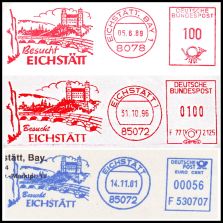 |
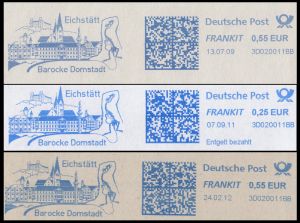 |
| Jura Museum im Eichstaett on meter franking of Germany | |
The focus of the exhibition is on the fossils of the Solnhofen plate limestones, which were unearthed by the intensive quarrying activity in the region.
The fossils allow visitors to travel back in time to a tropical island, reef and lagoon landscape around 150 million years ago, which was populated by fish dinosaurs and crocodiles, coral fish and crabs, insects and pterosaurs.
Among the most impressive fossils are the world’s only specimen of the predatory dinosaur Juravenator and an original of the famous prehistoric bird Archaeopteryx. (The Eichstätt Specimen was discovered in 1951 near Workerszell, Germany and described by Peter Wellnhofer in 1974. It is the smallest specimen, from 12 specimens known to date, and has the second best head.)
Magnificent aquariums with reef corals, colourful coral fish and “living fossils” Nautilus bring to life the colourful diversity of marine life from the Jurassic period, 150 million years before today.
A multimedia museum guide, which guests can use on their own smartphones, offers a tour of the most important exhibits. Videos and interactive elements provide exciting insights into the Jurassic period.
The Jura Museum was opened in 1976 as a state-run museum sponsored by the Episcopal Seminary in St. Willibald Eichstaett and has since fulfilled an explicit research and educational mandate. [R33]

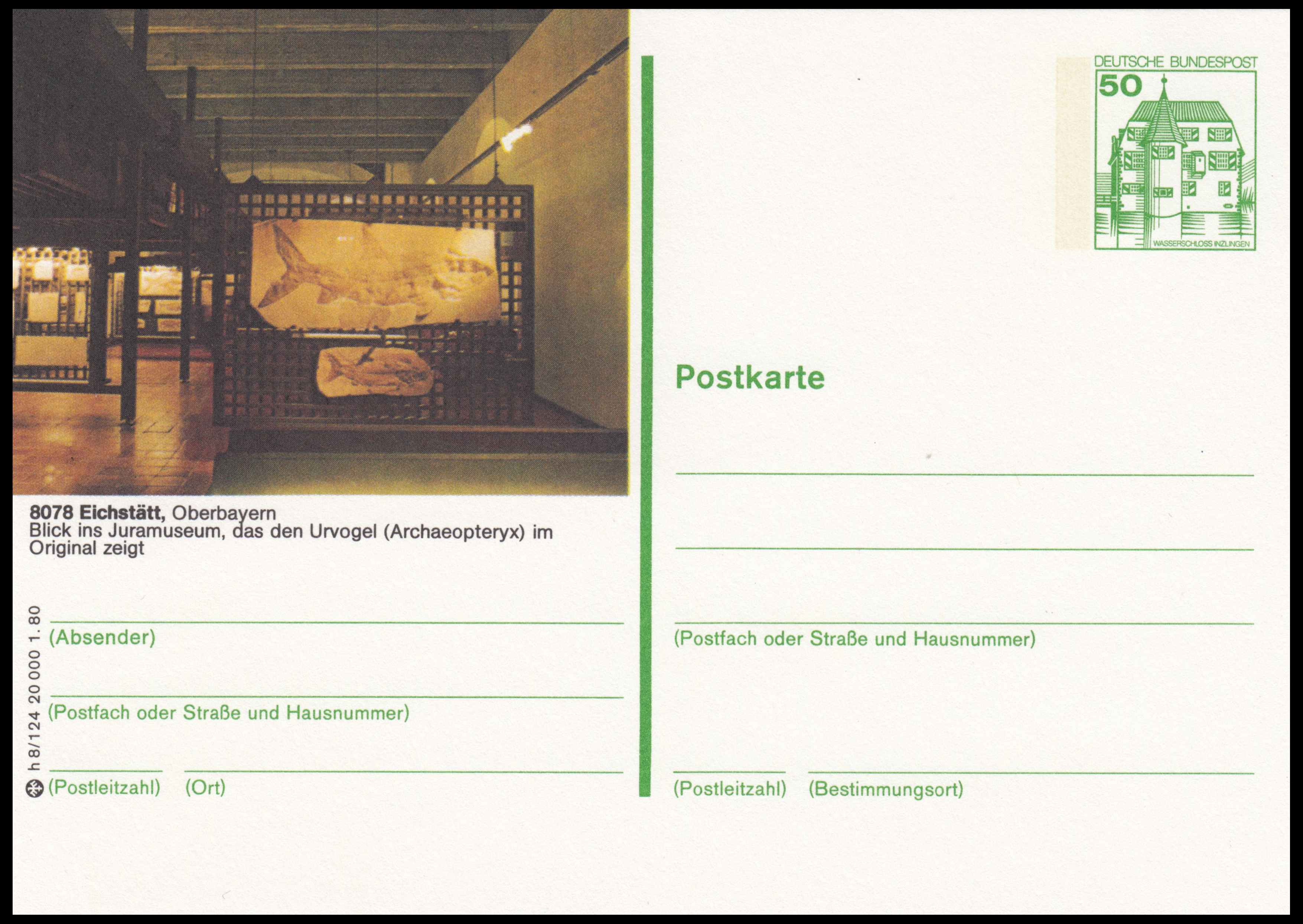
|
The building of the Museum, includung dinosaurs on the front
- postmarks "Visit Eichstaett", Germany 1977-1993
- postmarks "Visit Eichstaett", Germany 1980-1986
- meter frankings "Visit Eichstaett", Germany 1989-2001
- meter franking of Eichstaett, Germany 2009-now. The meter franking shows the building of the Museum (the castle) and Juravenator.
- fish fossils from exposition of the Jura Museum on a postal stationery (postcard), Germany 1980.
- meter franking of Eichstaett, Germany 2009-now. The meter franking shows the building of the Museum (the castle) and Juravenator.
Germany: LWL-Museum of Natural History Westphalian State Museum (NHMM)
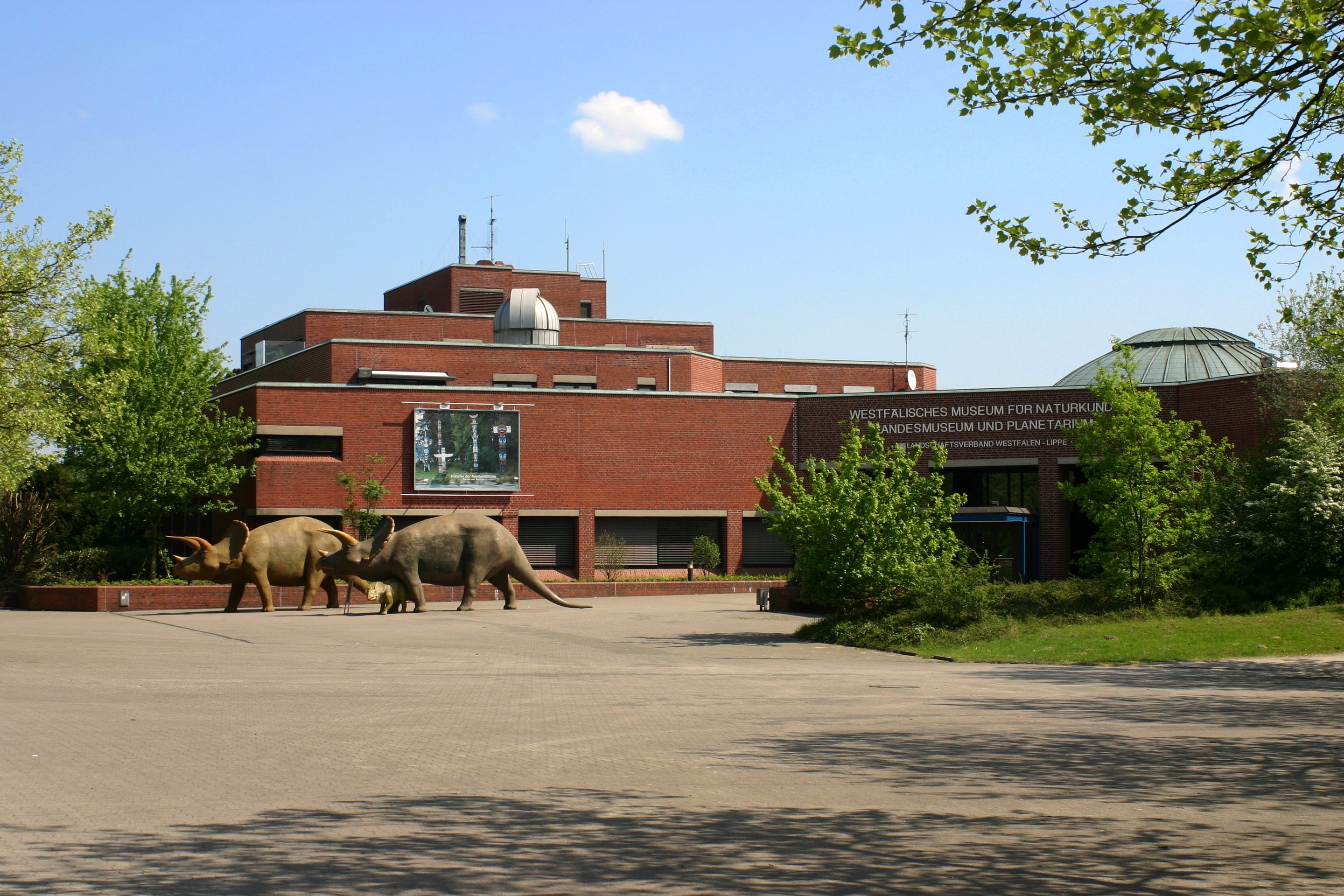
|
| LWL-Museum of Natural History Westphalian State Museum. Image credit: Wikipedia |
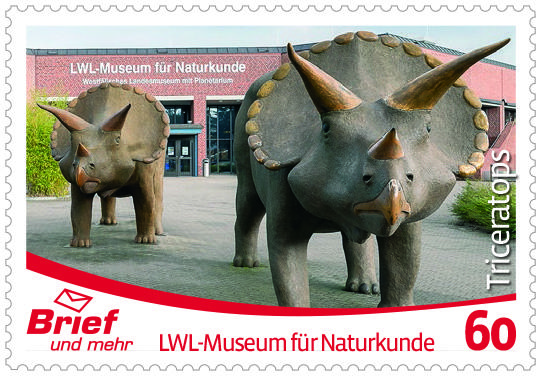
|
| Sculptures of Triceratops at the entrance of LWL-Museum of Natural History Westphalian State Museum on postage stamp of local post company Brief und mehr, Germany 2017. |
It includes the Natural History Museum (Westfaelisches Landesmuseum), the planetarium, the biological station in the Holy Sea branch, which is located in the communities of Recke and Hopsten, the Kahler Asten branch and the paleontological preservation of archaeological monuments for Westphalia-Lippe.
The museum is located in the vicinity of the Allwetterzoo Muenster and the Muehlenhof-Freilichtmuseum Muenster am Aasee on Sentruper Straße.
The museum opened its doors in 1892. Its first director was Hermann Landois, the founded the "Provincial Museum of Natural History" on the site of the zoological garden on the Himmelreichallee in Münster.
The museum was initially intended to present the natural history testimonies of Westphalia.
In 1981, the museum moved to the new building and was integrated withe large planetarium. The former building on Himmelreichallee now houses the Westphalian School of Music, in whose courtyard there is a cast of the ammonite from the foyer of the Natural History Museum.
The new building has around 4,200 square metres of exhibition space, the LWL Museum for Natural History shows a wide variety of exhibitions on global topics and regional nature, including paleontological exhibition.
In addition to the permanent exhibitions, you can also discover the changing special and picture exhibitions. The 3,500 square meter museum courtyard offers even more attractions.
One of the permanent exhibits of the museum is Dinosaurs - prehistoric times are alive! (in German: Dinosaurier – Die Urzeit lebt!) This exhibition deals with the life and evolution of dinosaurs and other prehistoric animals.
Covering more than 850 square meters, the permanent exhibition answers exciting questions about the life and evolution of dinosaurs and other prehistoric animals. The exibition shows a world full of strange and at the same time familiar colours, sounds and life forms. In addition to a large number of skeletons, models, preparations and real fossils, interactive media, animations and films provide an exciting variety. [R32]

|
| Dinosaurs exhibition in LWL-Museum of Natural History Westphalian State Museum. Image credit: website of LWL-Museum of Natural History Westphalian State Museum |
Known Philatelic items:
The building of the Museum, includung dinosaurs on the front
- meter franking "Natural History Museum of Muenster - Planetarium", Germany 1982
- meter franking "100th anniversary of Natural History Museum of North Rhine-Westphalia in Muenster", Germany 1992
- postmark "100th anniversary of Natural History Museum of North Rhine-Westphalia in Muenster", Germany 1992
- postmark "Stamp collector club of Muenster. Dino meeting point", Germany 2011
- postmark "Stamp collector club of Muenster. Dino meeting point", Germany 2011
- set of 6 postage self-adhesive stamp of local post company Brief und mehr "125th anniversary of Natural History Museum of Muenster (NHMM)", Germany 2017
- two stamps of the set from 2017 were reprinted by Brief und mehr in 2019 with different face values. One of the stamp shows Triceratops
Germany: Paleontological Museum of Munich
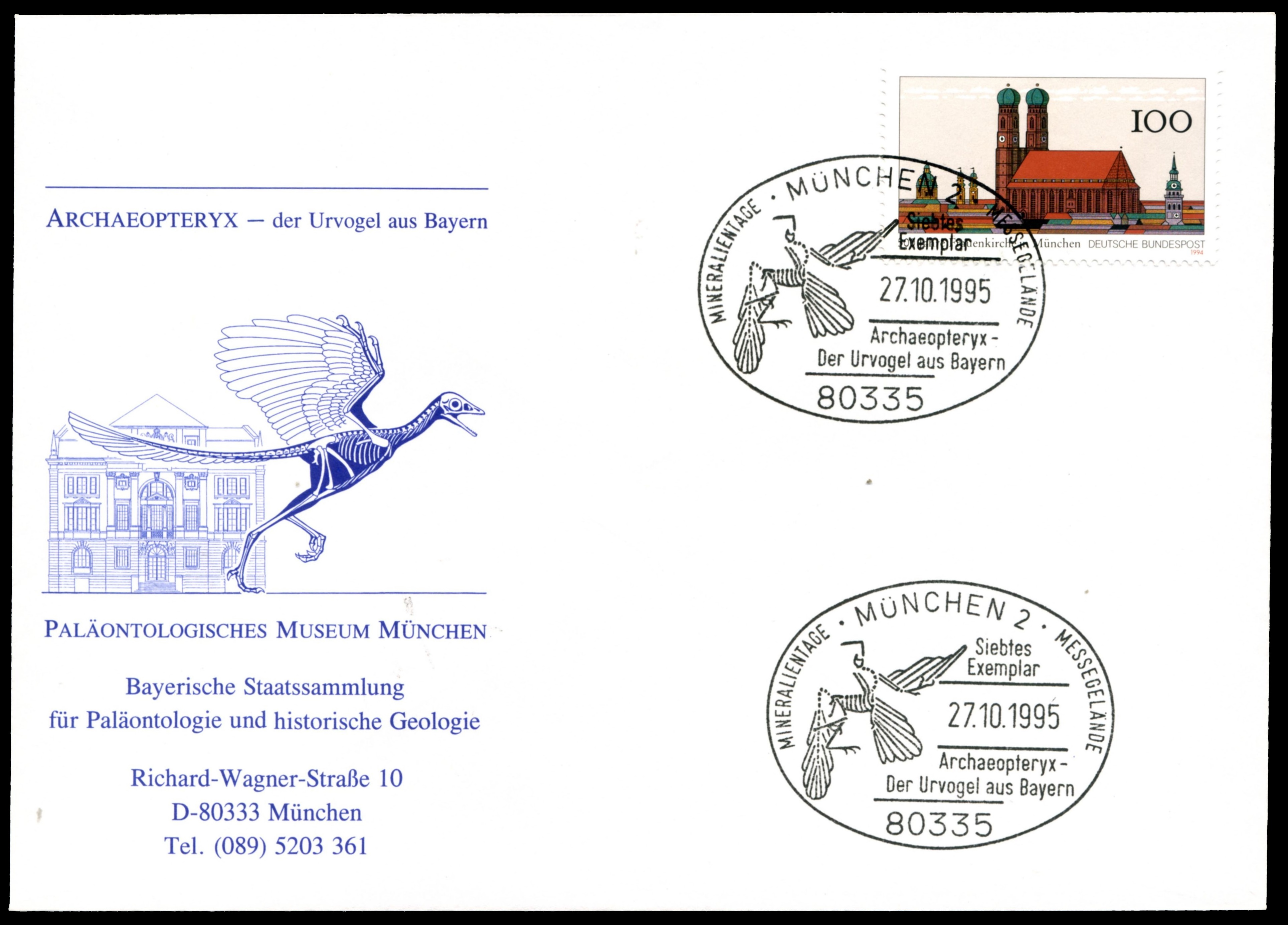
|
| Commemorative cover of Paleontological Museum of Munich, Germany 1995 |
It is associated with the Ludwig-Maximilians-Universität. It has a large collection of fossils of animals and plants such as Mesozoic reptiles, early elephants and saber-toothed cats.
The paleontological and geological institute which houses the museum is formally called the Bavarian State Collection for Palaeontology and Geology (in German: Bayerische Staatsammlung für Paläontologie und Geologie, BSPG), which itself is one of several institutions which make up the Bavarian Natural History Collections (in German: Staatliche Naturwissenschaftliche Sammlungen Bayerns, SNSB).
One of its highlights is the specimen of the early bird Archaeopteryx discovered in 1861 (see on the postmark on the right).
The museum is also interesting because of the architecture of its building, the former urban college of arts and crafts. [R36]
Known Philatelic items:
From 1991 to 2014 the Paleontological Museum of Munich were issued many commemorative covers for the annuals mineral and fossil trade shows in Munich.
Germany: The Senckenberg Natural Research Society

|
| Postal stationery "200th anniversary of The Senckenberg Natural Research Society", Germany 2017 |

|
| Meter franking of Senckenberg Natural History Museum and Investigation Institute, Germany 1967 |
The society was founded by Frankfurt citizens on 22 November 1817 on the initiative of Johann Wolfgang von Goethe (one of the most famous German writer), and is named for the physician, naturalist, botanist and philanthropist Johann Christian Senckenberg (1707–1772).
The Senckenberg Nature Research Society owns several research institutes and museums, such as the Naturmuseum Senckenberg in Frankfurt am Main with an extensive collection of Dinosaurs, some of them depicted on German stamps in 2008.
The Senckenberg Natural History Museum and Investigation Institute used the skull of Triceratops for many years, The oldest known to me is dated 1967. [R35]
Known Philatelic items:
The building of the Museum, includung dinosaurs on the front
- meter franking "150th anniversary of Senckenberg Natural History Museum and Investigation Institute", Germany 1967-1987
- commemorative postmark "100th anniversary of Senckenberg Museum", Germany 2007
- postal stationery "200th anniversary of The Senckenberg Natural Research Society", Germany 2017 (see on the right)
- meter franking "150th anniversary of Senckenberg Natural History Museum and Investigation Institute", Germany 1967-1987
- meter franking "Senckenberg. Be a member of Natural History Museum and its research institute.", Germany 1990-1992
- meter franking "Senckenberg. Be a member of Natural History Museum and its research institute.", Germany 1992-1994
- stamps set "For the Youth - Dinosaurs - Block issue", Germany 2008
Germany: Spengler Museum
The Spengler Museum is a local history museum in Sangerhausen. It was opened in 1952 and is considered the first museum built in the German Democratic Republic (GDR) era.
In the first half of the 20th century, the Sangerhausen local historian Gustav Adolf Spengler (1869-1961) collected a wide variety of exhibits. His own house quickly became too small for the huge pool of his research work, so the city of Sangerhausen bought up a large part of his collection in 1937. In 1952, the Spengler Museum opened its doors for the first time as the first completely new museum building in the GDR. The construction was organized on a purely municipal level, since it was feared that the collection holdings would be withdrawn.
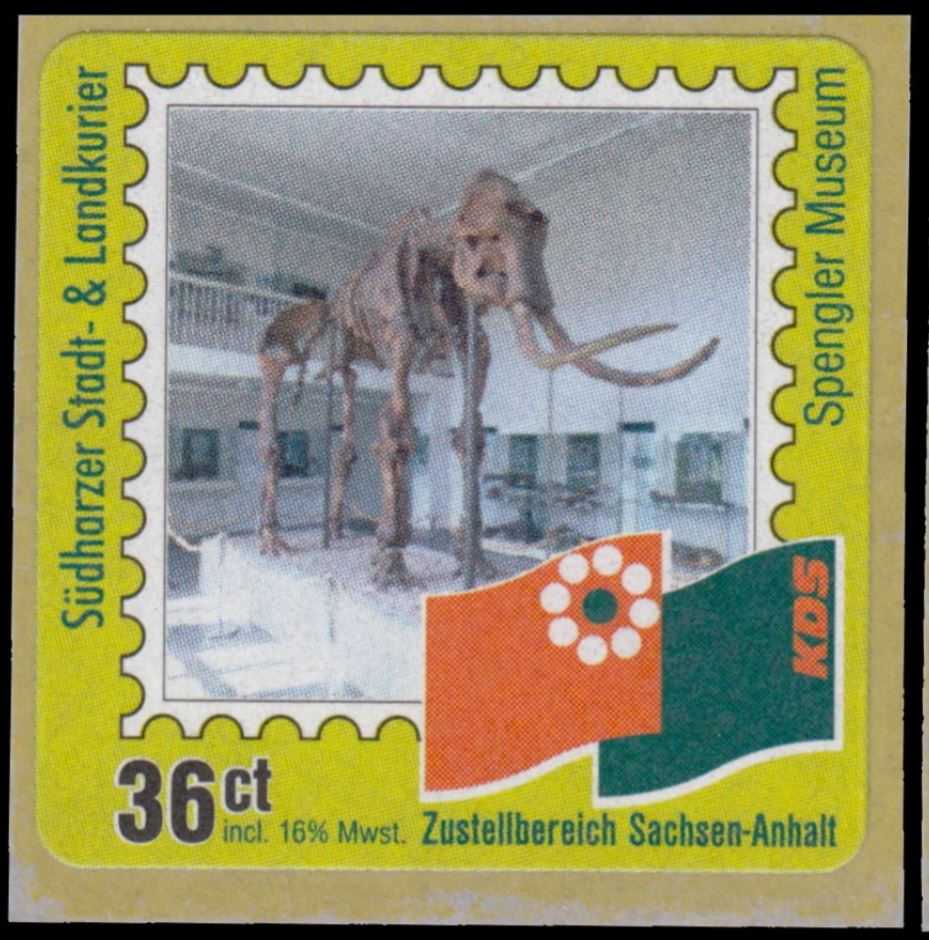
|
| Steppe mammoth, Mammuthus trogontherii on stamp of local post company Suedharzer Stadt und Landkreiskurier of Germany 2003 |
Since September 1, 2001, Spengler's former home at Hospitalstraße 56 has been part of the overall museum and shows the history of the family, the house and living around the year 1900.
A permanent exhibition presents exhibits on the topics of geology, natural history, the Ice Age, prehistory and early history, the Middle Ages, town history and the author and director Einar Schleef (1944-2001), who was born in Sangerhausen. There are also special exhibitions on a wide variety of topics throughout the year.
The skeleton of a mammoth is regarded as a special feature of the Spengler collection. It is the only complete skeleton of a steppe mammoth (Mammuthus trogontherii) in Germany. Gustav Adolf Spengler made the greatest find of his life in 1931 near Edersleben. The excavation work lasted two years in the gravel pit Edersleben by Gustav Adolf Spengler. The prepared skeleton was placed in the large hall of the Spengler Museum and has been one of the symbols of the town of Sangerhausen ever since.
It is a female specimen for which an age of 45 - 50 years is estimated. It lived before the Ice age about 500 000 years ago. [R31]
Known Philatelic items:
Fossils from collection of the Museum
- two self-adhesive stamps (same design, but different face values) depicted Steppe mammoth, Mammuthus trogontherii, issued by local post company Suedharzer Stadt und Landkreiskurier of Germany 2003
Germany: The Stuttgart State Museum of Natural History (Staatliches Museum für Naturkunde Stuttgart), abbreviated SMNS
SMNS, is one of the two state of Baden-Württemberg's Natural History Museums. Together with the State Museum of Natural History Karlsruhe (Staatliches Museum für Naturkunde Karlsruhe) it is one of the most important repositories for state-owned natural history collections in the state.
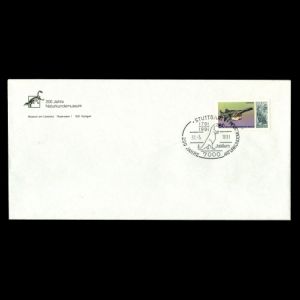 |
| Commemorative cover "200th anniversary cover of Natural History Museum of Stuttgart". Skeleton of Plateosaurus on the cachet and its reconstruction on the postmark. |
Exhibitions are shown in two buildings, both situated in the Rosenstein park in Stuttgart: the Löwentor Museum (German: Museum am Löwentor) houses the paleontology and geology exhibitions, while the Museum Rosenstein in Rosenstein Palace focuses on biology and natural history.
The Stuttgart State Museum of Natural History follows in the tradition of the Natural History Collection founded in 1791, which was based on the Ducal Cabinet of Curiosities of 1600.
Baden-Württemberg state of Germany is rich in fossils, including several famous classical localities.
Especially well exposed are terrestrial and marine Triassic, marine Jurassic and terrestrial Cenozoic sediments.
Therefore, the museum exhibits the early prosauropod dinosaur Plateosaurus and other terrestrial animals from the Lower and Upper Triassic (Buntsandstein and Keuper, respectively), a wide range of marine fossils, mainly invertebrates, from the Muschelkalk, and a plethora of ichthyosaurs, pliosaurs and plesiosaurs, as well as sharks from the Posidonia Shale and other Lower Jurassic formations.
Furthermore, exquisite Jurassic ammonites and other invertebrates are shown in large numbers. The Cenozoic is represented by invertebrates and mainly vertebrates from various German localities, including a pleistocene elephant and a copy of a mammoth mummy.
Also on exhibit is the skull of the prehistoric man of Steinheim (Homo steinheimensis). The museum also houses a spectacular collection of plant and animal fossils in amber. [R31]


Dinosaurs and prehistoric marine reptiles on exhibition of the Stuttgart State Museum of Natural History. Image credit official siteof the Stuttgart State Museum of Natural History.
Known Philatelic items:
Fossils from collection of the Museum
- The Stuttgart State Museum of Natural History, used meter franking with skeleton or reconstruction of Plateosaurus (the early prosauropod dinosaur), since 1989 at least: [1], [2], [3], [4],
- The Stuttgart State Museum of Natural History, used meter franking with reconstruction of Triceratops in 2005,
- Commemorative postmark "200th anniversary cover of Natural History Museum of Stuttgart", in 1991,
Germany: Museum Berger (Das Museum Bergér)
This is small, private, fossil museum located in Gut Harthof (a former monastery building) near Eichsaett (not far away from Solnhofen), was established 1968.
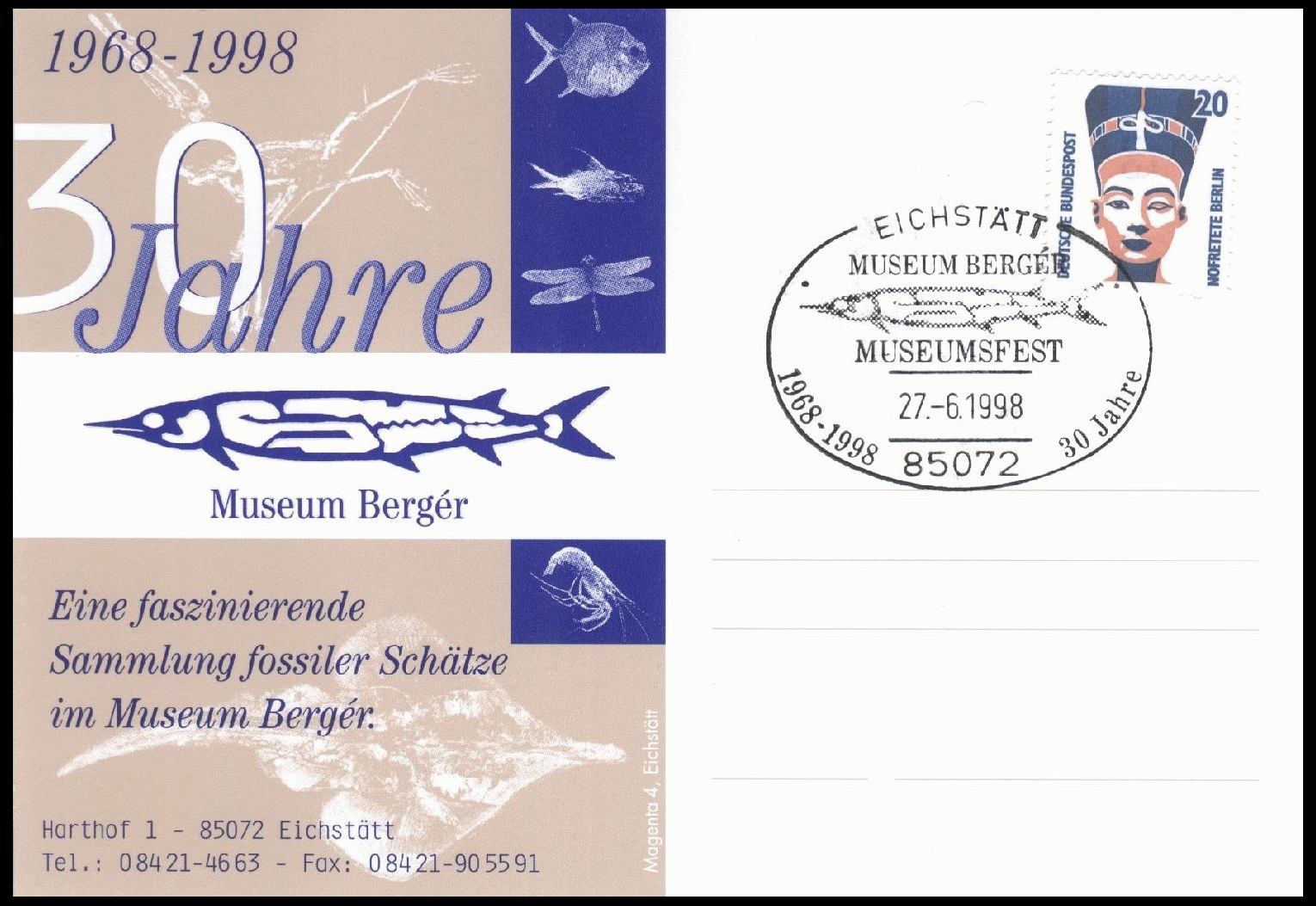 |
| Commemorative cover "30th anniversary of Fossil Museum Berger". |
For years he and his brothers collected fossils. Thousands of exhibits were painstakingly prepared. The most beautiful pieces can be admired in the museum.
All of the exhibits in the fossil collection were found in the Bergér family's quarries. A highlight of the collection are the insect fossils, including many dragonflies, which are in an unusually good state of preservation.
Over 800 different types of fossils have already been found on the Blumenberg quarry, including, for example, the primeval bird Archaeoperyx.
The original is on display in the Natural History Museum in Berlin, but a copy can be seen in the Berger Museum. Brightly lit display cases contain the "holotypes", fossils previously only found on the Bergér family's land. They include, for example, various crabs or the dragonfly "Bergeriaeschnidia abscissa".
The museum was modernized in 2008, to mark its 40th anniversary. [R35]
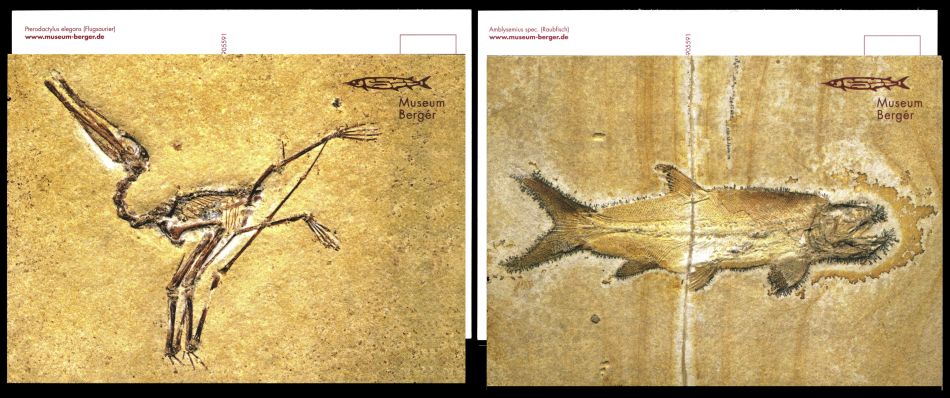
Fossils from collection of Museum Berger on postal cards of Germany.
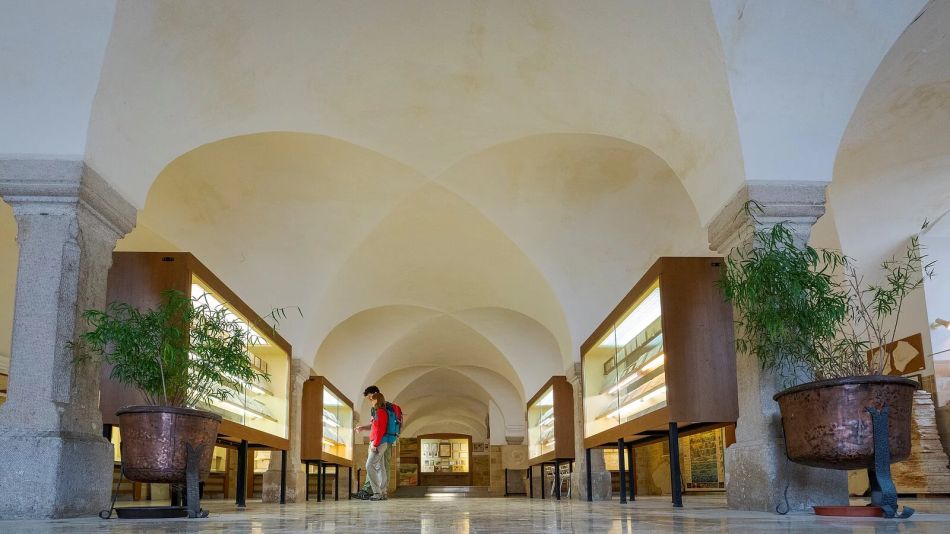
The hall of the Museum Berger. Image credit naturpark-altmuehltal,
Known Philatelic items:
Fossils from collection of the Museum
- Commemorative cover "30th anniversary of Fossil Museum Berger", Germany 1998 (see above)
- Commemorative postmark "30 years of Museum Berger: Museum festival", Germany 1998 (see above)
Germany: Auberlehaus Lore Museum in Trossingen
The museum was established in 1977, and was housed in a historic farmhouse built in 1718, the Auberlehaus in Trossingen. The building burned down in 1968. Since October 2014, the museum has also been one of 26 information points in the UNESCO Geopark Swabian Alb.
The Auberlehaus Lore Museum primarily contains information on the social history of the city in the city using reconstructed, furnished rooms and workshops illustrating 18th to early 20th century culture.
In addition to the information about the development of Trossingen from an Alamannendorf to a music city, there is also a paleontological collection.
Trossingen (a town halfway between Stuttgart and Zurich) is the world's largest dinosaur site from the Triassic.
For example, during several excavations in and around Trossingen, researchers found the remains of 55 Plateosaurus.
The first skeleton of Plateosaurus was discovered in Trossingen by a group of school boys in 1909, then excavated by the team of Prof. Eberhard Fraas from the Royal Natural History Cabinet in Stuttgart.
Plateosaurus is one of the first dinosaurs uncovered in Germany (1834) and one of the first dinosaurs known to the scientific community. The first appearance of Plateosaurus on a postal object is likely a postcard issued in the 1910s.
In 1979 the cast of first skeleton of a Trossinger Plateosaurus was installed in the museum.An exhibition on the subject of dinosaurs includes dinosaurs from different habitats, as well as petrified reefs, ammonites and turtles.
The paleontological collection in particular fascinates visitors thanks to the unusual visitor guidance through the exhibits with a black background. This makes the impressive exhibits particularly stand out. [R36]
Known Philatelic items:
Fossils from the collection of the Museum
- postal stationery, Germany 1984 - Auberlehaus Lore Museum in Trossingen shown on the cachet (see above).
- commemorative postmark, Germany 1993 - "275 years of Auberlehaus"
- personalized self-adhesive stamp and a commemoraive cover, issued by the museum in 2010 - "Time travel - Museum of Trossingen", show a skull of Plateosaurus engelhardti.
- the fossils from the collection of the museum were shown on several German commemorative postmarks:
- 1977 - "15th anniversary of stamp and coins collector club of Trossingen" - skeleton of Plateosaurus trossingensis
- 1984 - "10 years of partnership between Trossingen und Cluses (France)" - an ammonite
- 1988 - "25th anniversary of philatelic guild in Trossingen" - tortoise Proganochelis quendstedti
Indonesia
Museum Geology Bandung
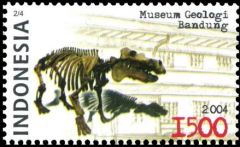 The Bandung Geological Museum is a technical unit in the Department of Energy and Mineral Resources.
Its collection includes minerals, rocks, fossils and some artifacts from the entire
archipelago of Indonesia.
This museum is one of the largest museums in Southeast Asia.
The Museum’s collection is archived and documented with a digital database with over 250,000 mineral and
rock samples and over 60,000 fossils of various age and type.
[R4]
The Bandung Geological Museum is a technical unit in the Department of Energy and Mineral Resources.
Its collection includes minerals, rocks, fossils and some artifacts from the entire
archipelago of Indonesia.
This museum is one of the largest museums in Southeast Asia.
The Museum’s collection is archived and documented with a digital database with over 250,000 mineral and
rock samples and over 60,000 fossils of various age and type.
[R4]
Related stamps: Indonesia 2004
Japan
The National Museum of Nature and Science The first museum in Japan was established at Yushima in Ochanomizu, Tokyo, in 1872.
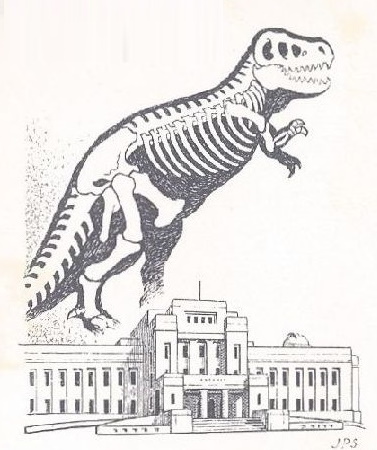 It then was called the Museum of the Ministry of Education and was designed
to exhibit zoological and botanical specimen as well as
various kinds of minerals and fossils.
It then was called the Museum of the Ministry of Education and was designed
to exhibit zoological and botanical specimen as well as
various kinds of minerals and fossils. The name of the museum was later changed to the Tokyo Museum, and in 1877 it made a fresh start as the Educational Museum.
This is the origin of the present science museum. In June, 1949, under the law for the establishment of the Education Ministry, the museum was placed under the jurisdiction of the Education Minister.
Its name was changed to the present National Science Museum. The only museum of this kind in Japan, the National Science Museum makes research and studies of the history of nature and natural science, exhibits data related to the studies for public view and contributes to the diffusion of knowledge concerning the history of nature and natural science among the people.
Today this museum is a guardian of a valuable collection of over 4 million specimens. The Museum’s extensive collection is presented in many exhibitions.
In 2010, the Museum welcomed over 1.8 million visitors.
The National Museum of Nature and Science serves as the central research institute for natural history and the history of science and technology.
The Museum collects and systematically organizes the specimens for the national collection, preserving this heritage for the benefit of the future generation.
As the country’s leading museum, the Museum also contributes to deepen the people’s appreciation of earth, life, science, and technology by promoting social education.
[R5]
Related stamps: Japan 1977
Moldova
The National Museum of Ethnography and Natural History of the Republic of Moldova is the first Moldavian museum.
It was founded in 1889 by baron Stuart (first, it was called "Zoological, Agricultural, and Handicraft Museum of Basarabia") and during the 20th century it was used as a laboratory by the local scientists: F. Ostermann, S. Miller, F. Porouchik, I. Sukhov, B. Taraboukhin, M. Pocoara and others.
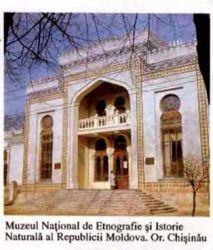 The Museum was constructed in 1905, and its Oriental style is unique in Moldova.
The Museum was constructed in 1905, and its Oriental style is unique in Moldova. Over the years, the Museum has maintained two basic directions for its scientific effort: ethnology and natural history.
Now it is famous for its geological, paleontological, zoological, entomological, archaeological, ethnographical and numismatic collections.
Among the thousands of Museum's exhibits, there is a fully articulated skeleton of the proboscid Deinotherium gigantismus, as well as famous archaeological treasures, Bessarabian carpets of the 19th century, etc.
The Museum’s collections are periodically loaned for exhibition in the museums of Europe, t he Americas, Asia, and Africa to highlight the cultural heritage of the Republic of Moldova. [R6]
Related stamps: Moldova 1995, Moldova 2014.

|
- [R1] The Museum of Natural History Vienna, Austria: official website, Wikipedia, Baron Karl von Hasenauer architect of the museum's building.
- [R2] The Royal Belgian Institute of Natural Sciences, Belgium: official website, Wikipedia.
- [R3] The Tianjin Natural History Museum, China: Wikipedia.
- [R4] Museum Geology Bandung, Indonesia:
- [R5] The National Museum of Nature and Science, Japan: official website
- [R6] The National Museum of Ethnography and Natural History of the Republic of Moldova:
- [R7] The Museum of La Plata Wikipedia, Official website (on Spanish).
- [R8] Haus der Natur Museum in Salzburg: official website, Wikipedia (in German).
- [R9] Krahuletsmuseum in Eggenburg, Austria: official website
- [R10] The Royal Museum of Central Africa, Belgium: official site, Earth Sciences Collection
- [R11] National Museum of Natural History, Bulgaria: Wikipedia, official website
- [R12] The Royal Ontario Museum, Canada: Wikipedia, official website
- [R13] Royal Tyrrell museum of Paleontology, Canada: Wikipedia, official website, Drumheller Municipality ,
- [R14] The Beijing Museum of Natural History: Wikipedia, official website, travelchinaguide.com
- [R15] Chilean National Museum of Natural History: Wikipedia
- [R16] Zigong Dinosaur Museum, China: official website, Wikipedia, mydinosaurs.com, Youtube "Welcome to Zigong Dinosaur Museum!".
- [R17] Dinosaurs Park in Changzhou, China: Wikipedia, chncia.org.
- [R18] National Museum of Costa Rica: official site
- [R19] Xixia Dinosaur Relics Park: china.org.cn
- Dinosaur eggs from Nanyang City of Henan Province: Macroelongatoolithus (Wikipedia), Prismatoolithus (Wikipedia), a-dinosaur-a-day.com
- [R20] The National Museum in Prague: official website, Wikipedia, praguemorning.cz, prague.eu.
- [R21] The Natural History Museum the Dominican Republic official website, Second Wiki.
- [R22] The Egyptian Geological Museum
Wikipedia,
official website.
- Arsinoitherium (Wikipedia)
- [R23] Guzman National Museum, El Salvador Wikipedia (on German), Expedia, cultura.gob.sv,
- [R24] National Museum of Natural History, France Wikipedia
- Wikipedia
- hominides.com
- [R25] Museum of Lodeve (Musee Fleury), France official website.
- [R26] Savigneen Museum, France official website,
- Wikipedia (in French)
- [R27] Dinosaur museum in Esperaza, France official website, midi-france.info.
- Wikipedia (Wikipedia)
- [R28] Natural History Museum of Reunion, France Wikipedia, departement974
- [R29] Museum of Natural Science in Berlin (Museum für Naturkunde in Berlin) official website, Wikipedia
- [R30] Museum of Natural Science in Chemnitz (Museum für Naturkunde in Chemnitz) official website, Wikipedia (in German)
- [R31] Spengler Museum official website, Wikipedia (in German), st.museum-digital.de,
- [R32] LWL-Museum of Natural History Westphalian State Museum official website, Wikipedia (in German)
- [R33] Jura museum im Eichstaett
official website,
SNSB,
Wikipedia (in German)
ku.de (in German).
The Eichstätt Archaeopteryx's specimen: Wikipedia - [R34] The Stuttgart State Museum of Natural History official website, Wikipedia (in German)
- [R35] Museum Berger official website, naturpark-altmuehltal, Museum portal of Bavaria, Franken Tourismus, Blumenberg quarry,
- [R36] Museum Auberlehaus in Trossingen official website, Wikipedia (in German), trossingen.de,
- [R37] The “Bernardino Rivadavia" Argentine Natural Sciences Museum (MACN — CONICET)
Acknowledgements:
Many thanks to Dr. Peter Voice from Department of Geological and Environmental Sciences, Western Michigan University, for the draft page review and his very valuable comments.
